![]()
![]()
![]()
Use LEFT and RIGHT arrow keys to navigate between flashcards;
Use UP and DOWN arrow keys to flip the card;
H to show hint;
A reads text to speech;
544 Cards in this Set
- Front
- Back
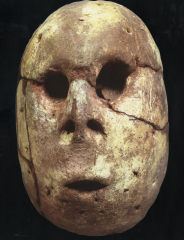
What dynasty is it from? What culture is it from? What is this? Why is this important? |
PreDynastic Period
Merimda, Lower Egypt
Human idol
Evidence for artistic and cult activity |
|
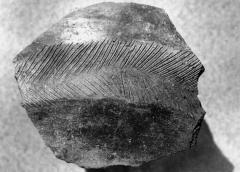
What dynasty is it from? What culture is it from? What is this? Why is this important? |
PreDynastic Period
Merimda, Lower Egypt
Potsherd
Evidence for artistic and cult activity |
|
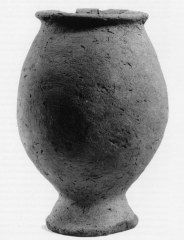
What culture? Where is it from (Delta or Valley)? What dynasty? Why is this important? |
Ma'adi Culture
Delta
PreDynastic Period
Maadian culture spread around Delta |
|
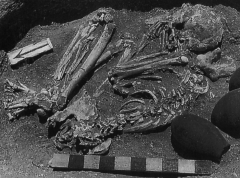
What culture? What dynasty? Where is it from (Delta or Valley)? Why is this important? |
Ma'adi Culture
Delta
PreDynastic Period
Fetal position was popular at this time; not sure what this position represents |
|
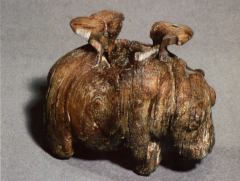
What culture? What dynasty? What is this? |
Badarian culture
PreDynastic Period
ivory hippopotamus - crafts become more important |
|

What culture? What dynasty? What is this? |
Badarian culture
PreDynastic Period
fine pottery made to look like metal; crafts become more important |
|

What culture? What dynasty? What is this? Why is it important? |
Badarian culture; PreDynastic period
female idol (small sculpture) : we don't know what she represents or who she is; there is some sort of ideology involved (where they Gods or ancestors?)
first time idols start to appear |
|
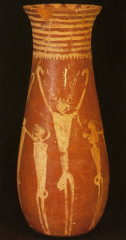
What culture? What dynasty? What is this?
|
Naqada I; PreDynastic
A pot-- big man with his arms up wearing stick crown and two guys on either side stuck together by their necks |
|
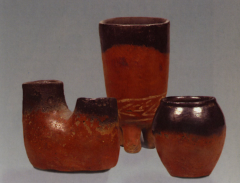
What culture? What dynasty? What is this? Why is this important? |
Naqada I; Predynastic
pottery is distinctive of the Naqada I culture (bright red clay with the black lace)
we find this pottery spreading north an south over time= spread of people, ideas, things |
|
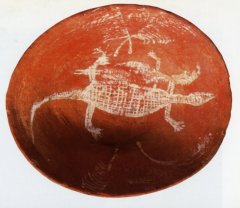
What culture? What Dyn? What is it? Importance? |
Naqada I PreDyn Pottery (dish) We start to see depictions of ppl and animals on pottery |
|
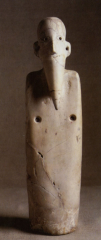
What time period is this from? What can they tell us about that culture? |
Naqada I, PreDyn
coned beard; may represented later Egyptian cultures ("kingship"; protoking or protoGod) |
|
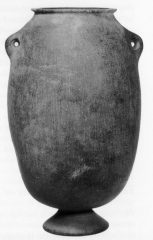
What time period is this from? What can they tell us about that culture? |
Naqada I; PreDyn
imported pot from Maadi culture in Delta= trade |
|
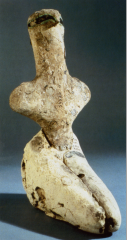
What time period is this from? What can they tell us about that culture? |
Naqada I; Pre Dyn
Female idol-- continues to be popular |
|
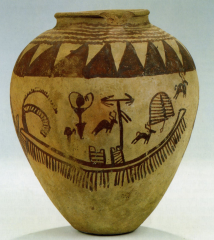
What time period? What are the details and what do they mean? |
ships very popular: symbolic meaning? - boats were their main mode of transportation, may also be where people lived - standards continue to be seen in the dynastic periods; they represent the family or place that the person is from - woman with arms raised above |
|
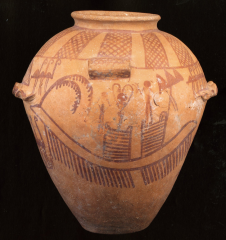
What time period? What are the details and what do they mean? |
see how identical the pots are; same boat with cabin, women with raised arms |
|
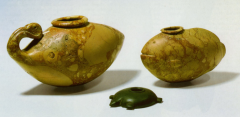
Time period? What are they? What can they tell us? |
Naqada II; PreDyn
stone vessels: very popular in this period; used for perfume
- Evidence for specialized workshops (advanced craftsmanship) |
|
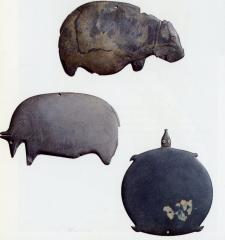
What time period? What are they? |
Naqada II; PreDyn
- these are palettes |
|

What time period? What is this? why is it important? |
Naqada II; Pre Dyn
- idol: staff with carved head of bearded man. Ivory. Case to hold instruments? |
|

What time period is this from? What is it? What can they tell us about that culture? |
Naqada II; PreDyn
- Female idol with her head shaped like a bird, broad hips, raised arms.
- New for this time period (animal heads are not uncommon overall in Egyptian art) |
|
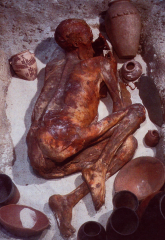
What time period is this from? What can they tell us about that culture? |
Naqada II; PreDyn
- we see ppl with more lavish goods than others; class differentiation - indication that there's an afterlife |
|
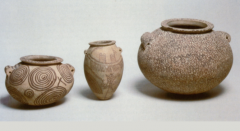
What time period is this from? What can they tell us about that culture? |
Naqada II; PreDyn
new style of pottery; mix of north and south (blending of valley and delta culture) pot with ear= delta style third pot= imitates stone pot (poor person can have a clay pot that looks like stone) |
|
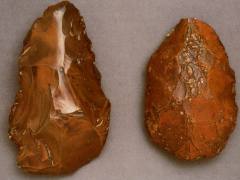
What time period is this from? What is it? What can they tell us about that culture? |
Early Paleolithic; PreDyn
stone tools, shaped by humans into something useful, axes, arrowheads, blades, mills, knives
One of the first evidence of the earliest people in Egypt |
|

What time period is this from? Where? What is it? What can they tell us about that culture? |
Naqada I; PreDyn
Hierakonpolis
first representation of painting on a wall
Battle |
|
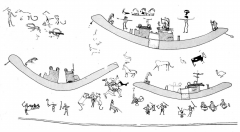
What are the motifs?
What's the importance of these?
Where are this depicted? |
Smiting scene= continuity (starts in this phase); a powerful guy taking a club and bashing someone over the head
man fighting two lions (or vicious animals)= "master of animals motif"; borrowed from Mesopotamia - ideas are starting to move form Mesopotamia to Egypt |
|
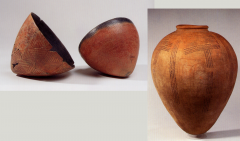
What time period? Where? What? Importance? |
Nubia; PreDyn Pottery they have an entirely different culture |
|
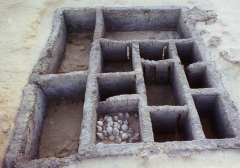
Where? Time period?
What? Importance?
|
Abydos, Late PreDyn
items (imported jars, like oil and wine) in tomb had labels (we have hiergraphic writing system near the end of the predynastic period); first time writing shows up
Beginnings of kingship |
|
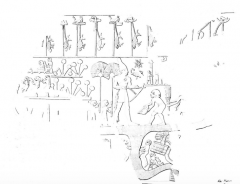
Time period?
Who's?
Main features? |
Dyn 0
Image on King Scorkpion's macehead; beginning of kingship
biggest figure is the King, wearing a white crown (named King Skorpion) |
|
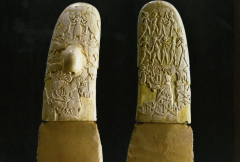
What is it?
Main motif?
Importance?
Time period? |
Gebel el Arak knife-- Stone knife with ivory handle
the master of beasts
style of knives and the outfit of the master of lions is from mesopotamia. artist came from mesopotamia to egypt or it was imported
Late Predynastic |
|
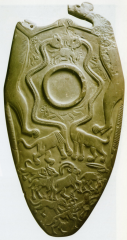
What is it?
Main motif?
Time period? |
Two Dogs Palette; Hierakonpolis; Late PreDyn
motif: animals, animals fighting, fabulous creatures (here=snake-necked panthers?) |
|
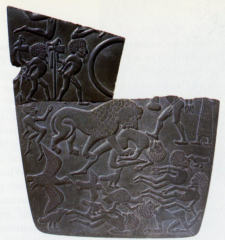
What is it?
TIme period?
Motif? |
Battlefield Palette, Late Predynastic
Common motif: battle scenes and war. Here captives taken by personified standards (holding bond captives together) |
|
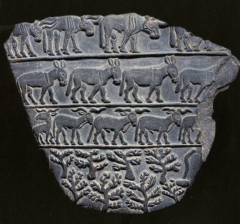
What is it?
Time period?
What does it depict? |
Cities Palette, Late Predynastic
Animals and orchard labeled “Libya” = booty from conquest? |
|
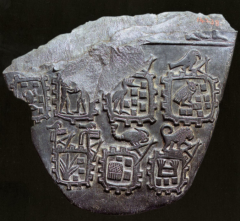
What is it?
Time period?
What does it depict? |
Cities Palette, Late Predynastic
King’s animals attacking symbolized cities (each square is a different region, attacking the cities are standards, and animals that are dear to the king) |
|
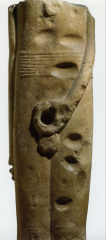
What is it?
Time period?
What does this tell you about the culture? |
Statue of the god Min, late Predynastic Period
the idols are now much bigger (first evidence for structures on a bigger scale) |
|
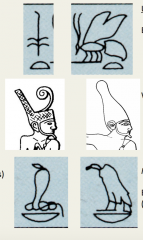
|
first column: lower egypt (delta), sedge (nesut), red crown (deschret), wadjit (snake goddess), tell el- Farain/ Buto (pe and dep)
Second column: upper egypt (nile valley), bee (bity), white crown (hedjet), nekhbet (vulture goddess), El-Kab and Hierakonpolis (Nekheb and Nekhen) |
|
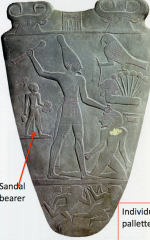
|
Dyn 0; Narmer; Palette (ceremonial( first time all these elements are depicted together: smiting scene, serekh, crowns of upper and lower egypt, royal standards, control of chaos |
|
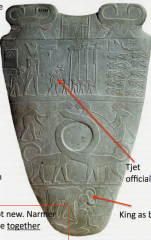
|
Dyn 0; Narmer; Palette (ceremonial( first time all these elements are depicted together: smiting scene, serekh, crowns of upper and lower egypt, royal standards, control of chaos |
|

|
Dyn 0; Narmer; Macehead • Vulture=goddess Nekhbet (Upper Egypt) • Boundary markers with runners: later boundary ritual? |
|
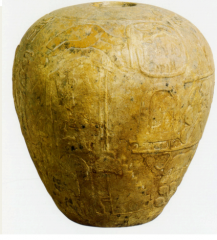
|
Dyn 0; Narmer; Macehead • Vulture=goddess Nekhbet (Upper Egypt) • Boundary markers with runners: later boundary ritual? |
|

|
Dyn 0-1; ivory royal figurine posture and robe is reminiscent of a later robe that is associated with Sed festival not sure if Sed festival was performed at this time - aspects of Kingship |
|
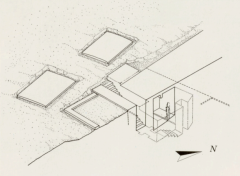
|
Tomb of Den; Abydos; Dyn 1 |
|
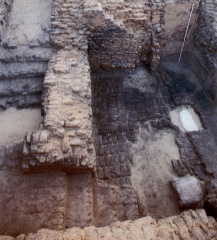
|
Tomb of Den; Abydos; Dyn 1 the Ka (spirit) lives on forever |
|
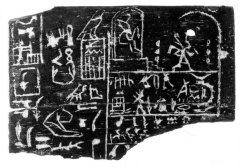
|
Dyn 1- label of Den |
|
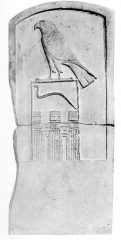
|
Dyn 1; funerary stelae; Wadj (Djet); Abydos |
|
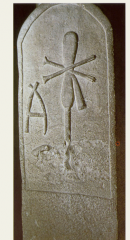
|
Dyn 1; funerary stelae; Queen Merneith; Abydos |
|
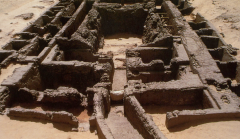
|
Tomb of Qu'a; Abydos Dyn 1
he made himself a stairway that they can build the tomb, put the body in, and they can still access the burial chamber after it was done (until they seal it) |
|
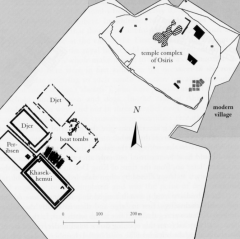
|
Dyn 1-2; ritual/ valley precincts; Abydos
where rituals took place (no real clue what happened; it is associated with the tomb |
|
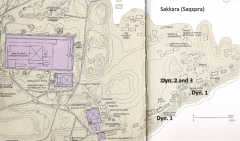
|
Dyn 1 Kings; Saqqara; cenotaphs |
|
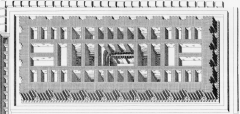
|
Niched mastaba, Saqqara, Dyn 1
“Palace façade”=relation to palace architecture and Near Eastern prototypes (same design as seen on the serekh)
they are still buried underground but there is a landscape |
|

|
Nicked mastaba, 1st Dyn, heads of cattle on base course
sign of wealth |
|

|
stone vessel in shape of basket, north Saqqara, Dyn1
petrifying things so that they last forever |
|
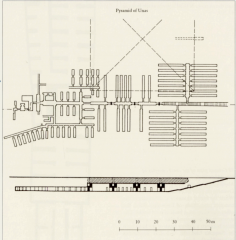
|
Tomb of Hetepsekhemui, first king of 2nd Dyn., Saqqara
Gallery tomb-- rooms for extensive quantity |
|

|
Stela from tomb of Nebre, 2nd king of 2nd D., Saqqara
We have never found the associated tomb |
|

|
Tomb of Khasakhemwy, Abydos, end Dyn. 2,
entire complex built of brick inside a single sunken pit (instead of cut out of rock like Saqqara)
influenced by gallery tombs |
|

|
Statue of Khasakhem(wy), Hierakonpolis, late Dyn. 2,
early known statuary, white crown and robe |
|

|
King’s name on the base , upside down to viewer • Fallen enemies around the base with one that has papyrus reeds and the number 47,209 which may be the number of people taken |
|
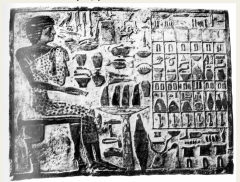
|
Funerary niche stone with offering list, Saqqara; Dyn 2
- offering stone, deceased sitting down on a bench facing a table with bread and a list (offering list)
|
|

|
• Peribsen: second to last king of Dynasty 2. • Breaks tradition and changes royal ideology: why? • Serekh topped by Seth animal not Horus falcon • Later ideology of god Seth: foreigner, desert, chaos, over‐thrower; does this apply now? |
|
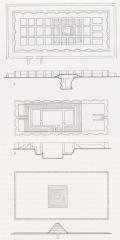
|
top: niched mastaba with shaft and internal mound
middle: niched mastaba with stepped mound
bottom: stepped pyramid with niched enclosure wall |
|

|
Mortuary complex of Djoser; dyn3; saqqara
first project built entirely of stone |
|

|
Djoser's pyramid complex; dyn 3; saqqara; modeled after palace (some buildings were non-functional) |
|
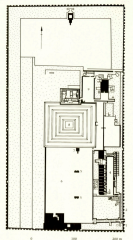
know the features |
Djoser's pyramid complex; dyn3; saqqara |
|
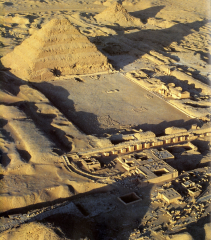
|
Djoser's pyramid complex; dyn3; saqqara |
|
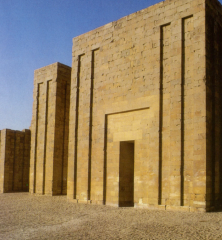
|
Djoser's pyramid complex; dyn3; saqqara
- 14 "false" entrance, one real one (here) |
|
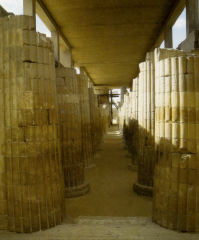
|
Djoser's pyramid complex; dyn3; saqqara
enter thorugh colonned hallway lined with half- columns resemble bundles of reeds pathway is narrow and dark (resembles journey to underworld) only to enter a bright, spacious courtyard (facing the South tomb) |
|
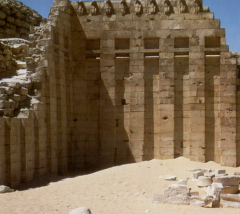
|
Djoser's pyramid complex; dyn3; saqqara
this border is an uraeus frieze (the cobra symbol that is aligned on top of the tomb); it meant something, but we don't know what |
|
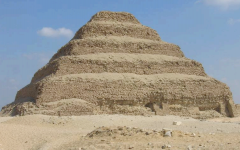
|
Djoser's pyramid complex; dyn3; saqqara
opening to that first mastaba |
|
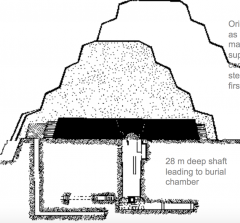
|
Djoser's pyramid complex; dyn3; saqqara
layer cake of mastabas |
|
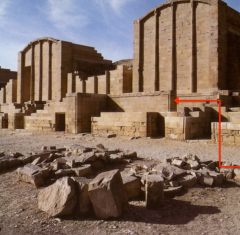
|
Djoser's sed festival courts; dyn3; saqqara
Sed festival// two thrones representing upper and lower, performed rituals at shrines representing provincial deities of upper and lower Egypt |
|
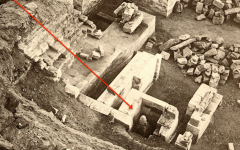
|
Djoser's serdab room; dyn3; saqqara
Serdab= cellar (a room with a statue with no doors to get to it); building against a pyramid (mortuary temple) |
|
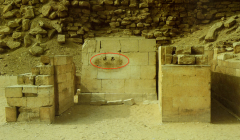
|
Djoser's serdab room; dyn3; saqqara
- the discoloration are from ppl putting their hands onlooking into the holes to see the King's statue (over centuries) |
|
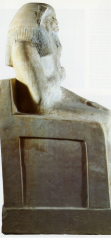
|
Djoser's Ka statue; dyn3, saqqara
|
|

|
Djoser's Ka statue; dyn3, saqqara |
|
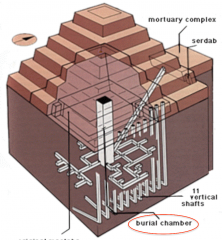
|
Djoser's pyramid; dyn3; saqqara
there was a maze of chambers under his tomb |
|
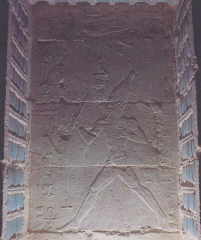
|
Djoser's south tomb; dyn3; saqqara
Raised relief panel (false doorway) showing boundary ceremony, under south tomb |
|
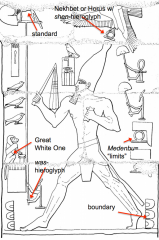
|
Djoser's south tomb; dyn3; saqqara
Raised relief panel (false doorway) showing boundary ceremony, under south tomb |
|

|
djoser's pyramid; 3rd dyn; saqqara
walls under the pyramid and south tomb were decorated with blue titles |
|
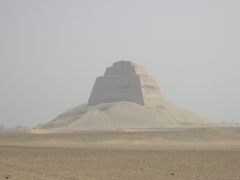
|
Stepped Pyramid of Snefru; Meidum; Dyn 4 |
|
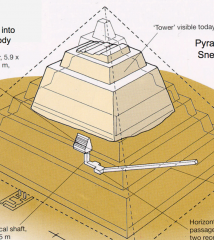
|
Stepped Pyramid of Snefru; Meidum; Dyn 4
added a casing outside that made it look like the sides were straight; burial chamber was corbelled |
|
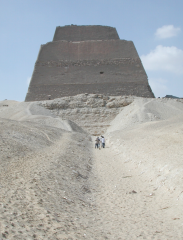
|
Stepped Pyramid of Snefru; Meidum; Dyn 4 |
|

|
The Bent Pyramid of Snefru; Dahshur; Dyn 4
he went straight to making straight sides (instead of making a casing after making a layer cake)
|
|
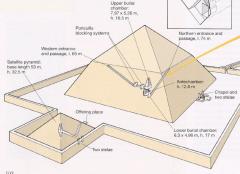
|
The Bent Pyramid of Snefru; Dahshur; Dyn 4
- corbelled vaults= open spaces created by layering stones slightly inwards until there is no more space to go (and then they cap it off) |
|
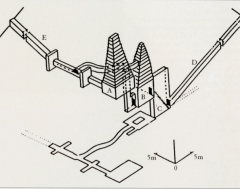
|
The Bent Pyramid of Snefru; Dahshur; Dyn 4
the stones started to crack after subsidence |
|
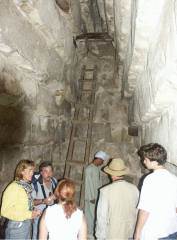
|
The Bent Pyramid of Snefru; Dahshur; Dyn 4
chambers built as they were building up the pyramid; it wasn't carved out |
|
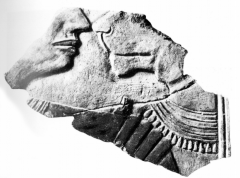
|
Valley temple of Snefru's bent pyramid
- fragment of the decorations in the niches (cut out of the set back area) |
|
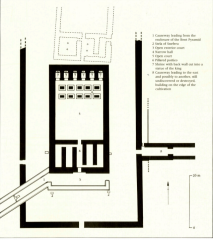
|
Valley temple of Snefru's bent pyramid
- called the Valley temple because it was located closer to the Valley - a lot of prep took place (the wrapping of the body, rituals when they took the King to the actual tomb) |
|
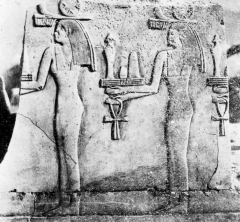
|
east wall of Valley temple entrance hall; Snefru's Bent pyramid; dyn 4
- when Ancient Egyptians depicted things on their walls on their tombs, it was "real" (it comes to live) and last forever these ladies represent the different estates |
|
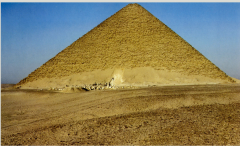
|
Snefru's red pyramid; Dahshur; Dyn 4 |
|
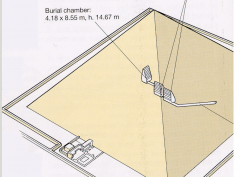
|
Snefru's red pyramid; dahsaur; dyn 4
- more simplified in the interior |
|
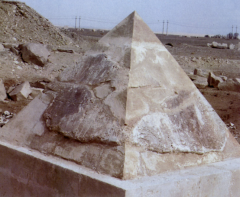
|
Pyramidion from Red Pyramid; Sneferu; Dyn 3; Dahshur
- the "point" on the pyramid = usually covered with a shiny metal so that it comes a becon when the sun hits it |
|
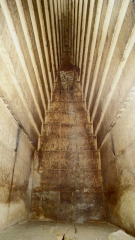
|
Burial chamber of Red Pyramid; Dyn4; Dahshar; Sneferu |
|

|
Pyramids of Giza, 4thD |
|
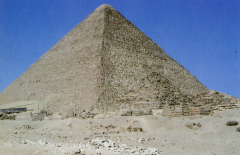
|
Khufu's Great Pyramid, Giza, Dyn 4
- the notion that the pyramids were built by a slave labor force imported from elsewhere was a false mythology - based on archelogical excavation, it takes about 10 thousand ppl at all times (less than 1% of the population of Egypt at the time - during the growing season, farmers were hired to work on pyramids for extra money or to pay off a debt |
|
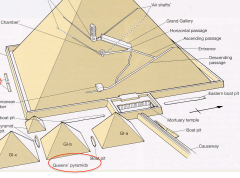
|
Khufu's pyramid plan
- relieving chambers; don't have corbelled vaults - started to build underground (represents underworld) - Queen's chamber was originally for the king, but he decided it was too small |
|

|
Khufu's pyramid
Grand Gallery corridor leading to burial chamber |
|
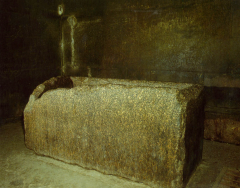
|
Khufu's sarcophagus
- tomb was too big for the door |
|
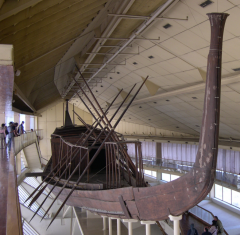
|
Khufu's ship (probably actually used in real life) was disassembled and buried |
|
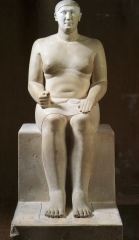
|
Hemiunu, one of Khufu's princes
- building manager of the pyramids very life like (unusually for 4th dyn elites) |
|
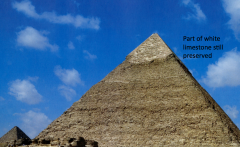
|
Khafre's pyramid dyn 4 |
|
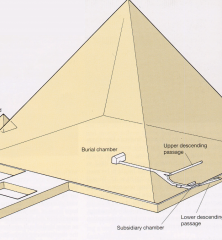
|
Khafre's pyramid
- some ppl they think this is too simple for the King |
|
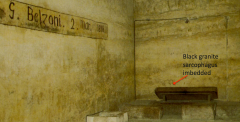
|
Burial chamber of Khafre
S. Belzoni discovered it - sarcophagus was built into the stone |
|
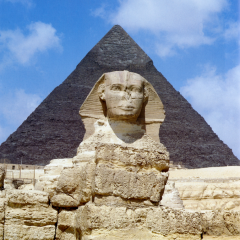
|
The Great Sphinx
- sphinx was probably already there (his father did); King Khafre re-purposed it to look like him - causeway was angled |
|
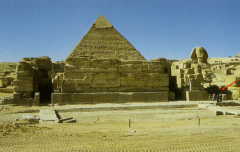
|
Valley temple of Khafre
- located in the valley from the causeway |
|
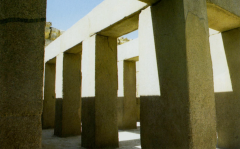
|
Pillared hall in Khafre's valley temple
- inside walls made of black stone |
|

|
Seated statue of Khafre
- buried in the floor is 23 seated statues of King Khafre
Both sides of the seat between the chair legs has the sema-tawy motif: symbolizes unification of the two lands: papyrus and lotus tied together around a windpipe and human lungs: word had same consonants as “to unite” |
|
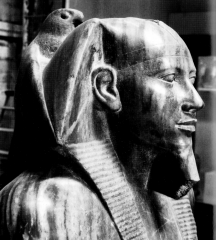
|
Khafre |
|
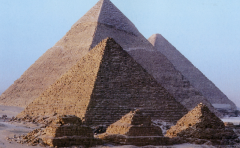
|
Menkaure; dyn4; giza |
|
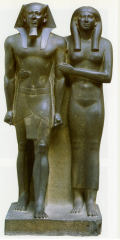
|
Menkaure diad with his wife
- still has his features although idealized (depicted as athletic) |
|
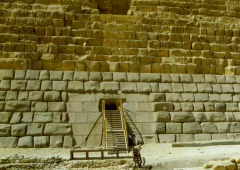
|
Menkaure's pyramid entrance and red granite facing |
|
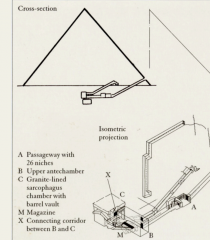
|
Menkaure's pyramid plan
- he went underground again |
|
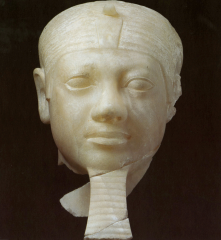
|
Head of Menkaure, valley temple
•A Saite period (2000 years later) coffin inscribed with Menkaure’s name found inside pyramid •Original stone sarcophagus lost at sea on the way to England. Doh! |
|

|
5th dyn pyramids at abusir
- not as nicely made and not as big |
|
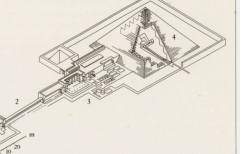
|
Typical pyramid complex of Sahure, 5th dynasty - valley temple, causeway, mortuary temple, and pyramid grand building that starts with an entrance way to an open court with columns (sun will come down)... then we get a separate corridor that is entire roomed and closed (dark)--> going from light to dark (obsession for duality)
|
|
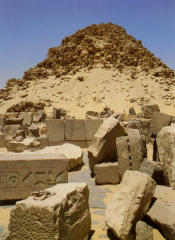
|
Pyramid and mortuary temple of Sahure, 5th dyn
•Continued the theme of using multiple colors of stone as a form of decoration: basalt (black) paving, red granite paving and columns. |
|
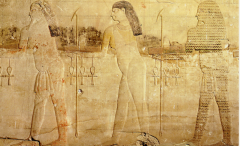
|
The Great Green One
mortuary temple of Sahure
procession of fertility gods |
|

|
Deities with captives (in a more active role)
Mortuary temple of Sahure |
|
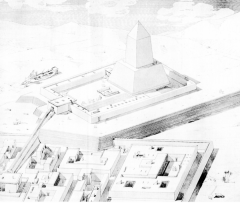
|
Solar temple of Niuserre, Abu Ghurob, 5th dyn
Ra got his own temple, the king was always important and worshipped (since 4th dynasty) but not to this degree |
|
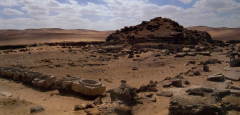
|
- outline of what is left of the enclosing wall of the obelisk |
|
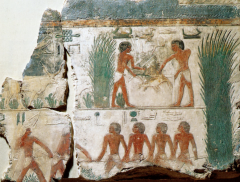
|
Reliefs from solar temple of Niuserre, Abu Ghurob
had to do with what the Sun liked: |
|
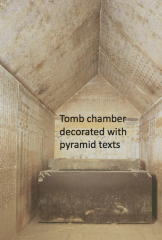
|
Pyramid texts of Unas, Saqqara, Dyn 5
- pyramid texts were directly connected to Osiris |
|
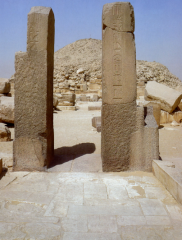
|
Red granite gateway into mortuary temple
|
|

|
Mortuary temple of Unas; Saqqara
- sign of legitimization |
|

|
Pyramid of Pepi II, south Saqqara, 6th dyn
last pyramaid complex of OK - we believe he's one of the reason why the Old Kingdom collapsed in the end |
|
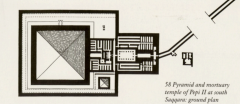
|
Pyramid complex of Pepi II
although poorly built, it still had the basic structures. - gigantic mortuary complex in comparison to the pyramid |
|
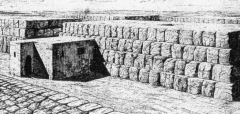
|
The mastaba
• Most common elite tomb type |
|
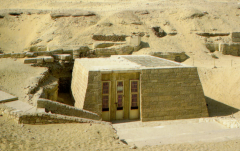
|
Saqqara, mid 5th D., Rock-cut tomb behind traditional mastaba.
|
|
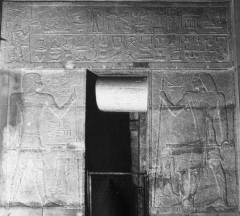
|
Entrance to tomb; OK
• Entrance to tomb chapel had all the elements of a house door: door jamb, lintel, frame and rounded drum for hanging a curtain • Deceased is shown entering his tomb (on both sides), accompanied by adult sons (but very small) • Entrances to elite tombs normally had an offering formula to Anubis over the doorway. |
|

|
Funerary repast scene; elite; started in 2nd D
• Determined what would be brought to him every day • Deceased shown seated facing right with right arm pointing to a table in front with half-loaves of bread. • Above the deceased are his names and titles as well as offering lists and depictions |
|
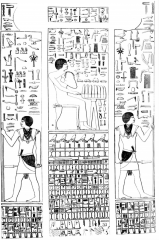
|
Offering niche; elite
• Here the repast scene is flanked by two depictions of the deceased, facing those who would be performing the rituals. • Not mirror images: staff (LH), hands, scepter (RH), and body- type (one older/heavier than other=two different periods of his life) |
|

|
False door; elite
• Typically, the repast scene was placed above the chapel’s false door • False door stood between the participants and the serdab room. • The liminal space where only the ka could pass through and receive the offerings. The boundary between the living and dead |
|
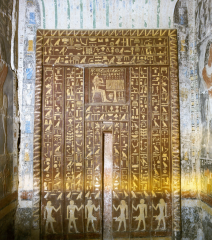
|
False door; elite; OK
cavetto cornice and torus molding. • 5th Dynasty onwards • Mimicked entrance to cult building • This one mimicks sandstone with brown paint • Deceased was a vizier to the king • The repast scene then spawned the decoration for the other walls of the chapel: what if these things stopped coming? |
|
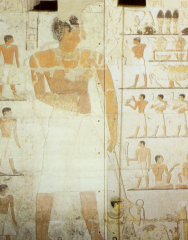
|
Serdab openings; elite; OK
• Serdab room located behind this wall: three horizontal slits allowed the ka’s statue to observe the rituals taking place. • Main image is the deceased receiving the offerings with three brothers behind him and wife at his feet. |
|
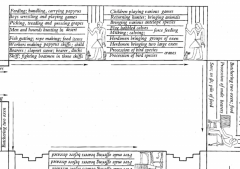
|
the four walls of the tomb; elites; OK
|
|
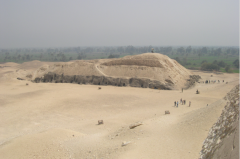
|
prince’s mastaba; OK: elite |
|

|
elite; OK
- the people are depicted flat (not muscular) in contrast to the natural imagery (they are perfectly depicted with a lot of detail) |
|
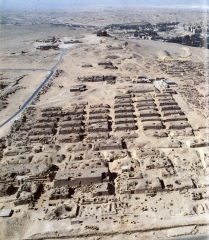
|
Western cemetry of Giza
Elites built their tombs near the king they served or whose cult they participated in. • During 4th Dynasty this was mainly at Meidum, then Giza. • 6th Dynasty elite began building their tombs away from the king, in their own nomes (territories) |
|
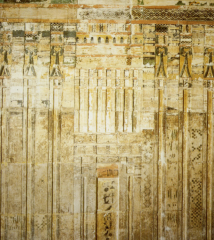
|
False door; elite
• Other false doors were more elaborate, modeled after the palatial niched façade. • From the 4th Dynasty onwards, rarely found because it implies royal connections; also combined with standard false door • This one is the primary false door for the “leader of singers, Khenu” |
|
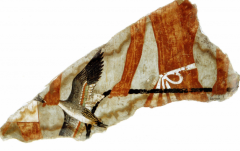
|
Relief; elite; OK
- the people are depicted flat (not muscular) in contrast to the natural imagery (they are perfectly depicted with a lot of detail) |
|
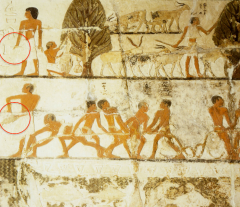
|
Relief; elite; OK
- this would be where the deceased person is; person in charge is giving the deceased person the papyrus record of what they did in the day |
|
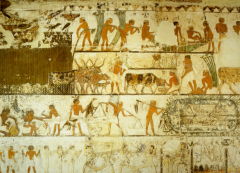
|
Relief; elite; OK scenes of everyday life - dancing, etc. |
|

|
Relief of animal sacrifice; OK; elite
cows being sacrifices (daily) |
|
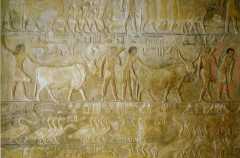
|
Display of cattle for sacrifice; OK; elite
cattle= wealth
depicts ppl in injury= everyday life |
|
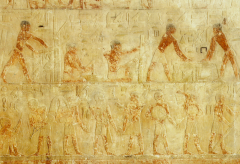
|
relief; OK; tradesmen and market
comic book style conversations |
|
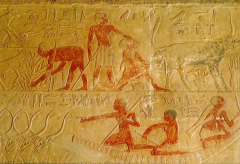
|
relief; OK; Cattle rearing
- a lot of scenes of cows giving birth |
|
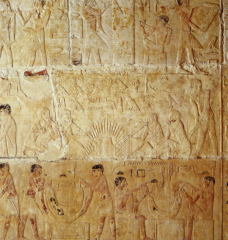
|
Relief; elite; OK
scene of tradesmen (sculptors and statues, metal workers with furnance, jewelers knotting broad collar necklaces) - there were inscriptions of their activity, titles, products, and conversations |
|
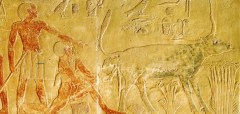
|
relief; OK; Cattle rearing
- a lot of scenes of cows giving birth |
|
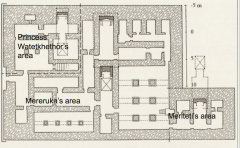
|
Elite Mastaba; OK
- huge mastaba that has a lot of interior chambers (for storage for example) |
|

what is it?
features? |
Elite; relief; OK
Hippo Hunt
- famous picture of the Hippo hunt (remember: life, death, rebirth) |
|
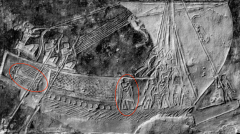
|
elite; OK; relief
Journey to the "beautiful west"
- symbolic journey in a boat (crossing from the land of the living to the land of the dead) |
|
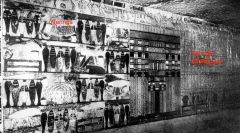
|
elite; OK; relief
Decorated burial chamber with checkered offerings and formal offering list |
|

|
Coffin; elite; OK
- coffin for normal people were made of wood or stone |
|
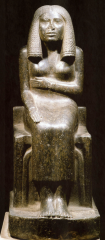
|
Private tomb staute (Serdab)
• Inscribing the statue with his or her name and giving individualized features directly identified the statue with the deceased. Only then could the ka use is. |
|
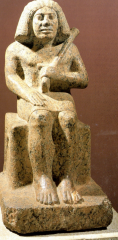
|
Private tomb statue (ship builder); OK
- those identifying features on statue can come from supplementary features (like a tool that he used a lot in his life) - 3rd Dyn.... because he is not as athletic as the 4th D kings |
|

|
husband and wife statue; elite; OK
- kilt is the fashion of the 4th dynasty |
|
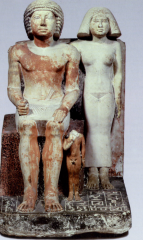
|
Family statue; elite; OK
• Man show much taller than woman because he is seated and she is standing (but their heads are same height). |
|

|
Group statue; OK; elite
- man is still taller than woman - her arm around his waist to know they are united |
|
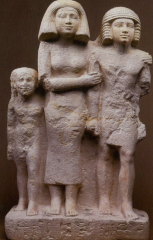
|
Group statue; OK; elite
• This is important because the woman is actually shown taller than the man—very rare. Possibly her two sons instead of husband. |
|
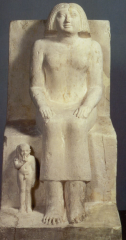
|
Group statue; OK; elite
• Sometimes women could have their own statues |
|

|
Statue of scribe; OK; elite
• Know he is a scribe because of: • “scribe’s pose”=cross- legged • Notice individualized features of the face, but idealized body. |
|
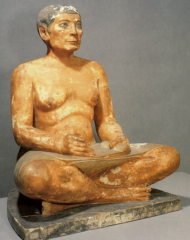
|
Statue of scribe; OK; elite
• Know he is a scribe because of: • “scribe’s pose”=cross- legged |
|

|
Alabaster statue of elite; OK
position: "manager of all the King's works" |
|
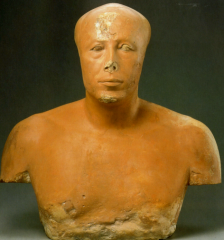
|
Bust; elite; OK
Unique Old Kingdom statue because of its realism, high degree of individuality. But it is not a normal tomb statue: it is a bust and the material is different ( |
|
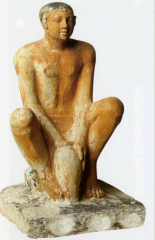
|
Servant figurines; elite tombs; OK
- 3d representation of their everyday scenes that were drawn on the walls |
|
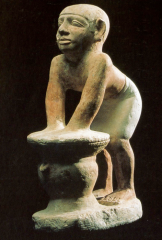
|
Servant figurines; elite tombs; OK
- 3d representation of their everyday scenes that were drawn on the walls |
|
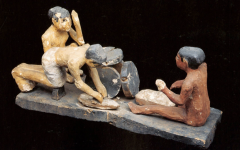
|
Servant figurines; OK: elite tombs
Making bread |
|
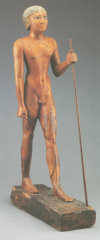
|
Wooden statue of elite; OK
Elites not normally shown nude. 5th and 6th Dynasty see this new type This does not mean lack of status. Perhaps they deliberately refer to nude image of child to symbolize rebirth. But they are not children since they are clearly circumcised whereas young boys are not. |
|
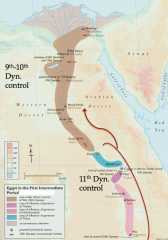
|
First Intermediate Period
- Dynasty 11 is separated from Dynasty 9 and 10 geographically —> war between 11 and 9/10 |
|
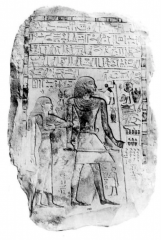
|
Stealae; FIP
- sunken relief (a lot of contrast) |
|
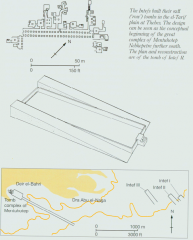
|
Saff Tombs; FIP El- Tarif; Intefs
- abandoned the pyramids and built open courts and their tombs against rocky cliffs behind it - the King in the intermediated period was elected (out of a bunch of nomarks) was more egalitarian (hierarchy was not as distinct) |
|

|
Statue of Mery, Thebes, FIP; elite
- Theban Pre- unificaton style - facial features are exaggerated |
|
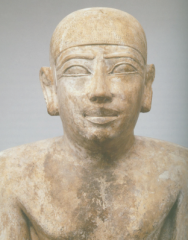
|
Statue of Mery, Thebes, FIP; elite
- Theban Pre- unificaton style - facial features are exaggerated |
|
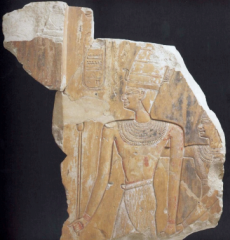
|
Montuhotep; Dyn 11; Deir el_ Bahari
- won the civil war against the North |
|
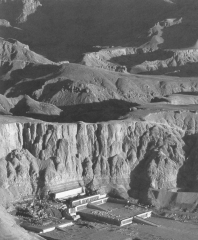
|
Montuhotep's mortuary complex; Deir el- Bahari; Thebes; Dyn 11
|
|
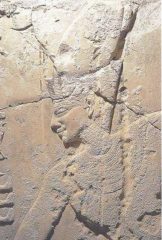
|
Mentuhotep; Dyn 11
- he straddled both periods so, he has two artistic styles that represent him |
|

|
Mentuhotep; Dyn 11; Deir EL- Bahari
- long causeway which leads to an open court yard, which was planted with trees |
|
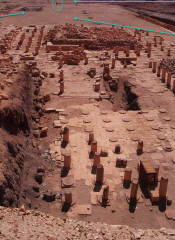
|
Mentuhotep; Dyn 11; Bab el- Hasan
king's first burial chamber before he decided to build the huge complex |
|
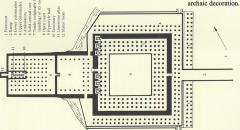
|
Mentuhotep; Dyn 11; Deir EL- Bahari; pyramid complex
6 tombs that were build for 6 of his Queens; but they decided built the big temple area) |
|

|
Mentuhotep; Dyn 11; Deir El- Bahari
these were all great places for decoration |
|

|
Montuhotep II; Dyn 11; Deir El- Bahari; postunificaiton style
- because he won, he had to legitimize himself in the eyes of the people in the North |
|
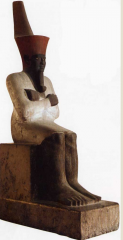
|
Montuhotep II; Deir el Bahari; mortuary complex
• Interestingly, statuary remained in the pre-unification style with large lined eyes, large ears, wide nose, large lips, little musculature. • Here, King Nebhepetra Montuhotep wears the sed-festival robe, the red crown of Lower Egypt, and once held the royal crook and flail. • Skin painted black-the color of Osiris, god of the dead. Found in an “Osiris tomb” under the burial structure. |
|
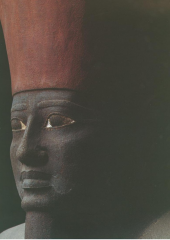
|
Montuhotep II; Deir el Bahari; mortuary complex
• Skin painted black-the color of Osiris, god of the dead. Found in an “Osiris tomb” under the burial structure. |
|

|
Standing figure of Montuhotep II, Deir el Bahari, Dyn. 11
This statue and many like it would have lined the processional way up the forecourt to the temple. The Red crown of Lower Egypt statues would have probably been place on the northern side |
|
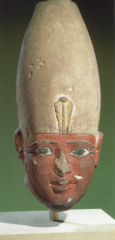
|
Head of Nebhepetre Montuhotep, funerary complex at Deir el Bahari, painted sandstone, 11th Dyn.
The opposing statue to the previous figure: the king wears the white crown of Upper Egypt here. These statues would have been place along the southern side of the processional way |
|

|
Relief fragment of god Montu embracing Montuhotep II, Deir el Bahari
Low, flat relief with little incised detail; contrast with the pre-unification style (eye is still in preunification style) |
|

|
Painted relief fragment of fallen Asiatics, mortuary temple of Montuhotep II, Deir el Bahari, 11th Dyn
Return to Old Kingdom themes: control of chaos=defeating foreign enemies |
|
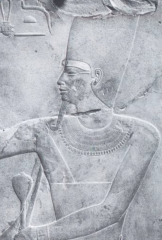
|
temple complex of Montuhotep, Dyn. 11
• Still post-unification style, but changing: change from the flat, plain relief of the later years of the reign of Nebhepetra to one where there was more modeling and incised detail.
middle kingdom style is in between Old Kingdom and Intermediate |
|

|
Relief of Amenemhat I, Pyramid complex at el‐Lisht, Dyn. 12
• Relief from funerary temple. • Temple itself is very badly damaged. • This is the upper half of a lintel (top of door). • Amenemhat I is in center wearing curled wig with uraeus and ceremonial beard. • Upper Egypt goddess Nekhbet, then Horus on left • Lower Egypt goddess Uto, then Anubis on on right. - not as flat as theh Old Kingdom (popping out effect) |
|
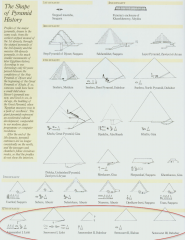
|
12th DYn: return of pyramids
- they were not built the same way as the ones in the Old Kingdom |
|
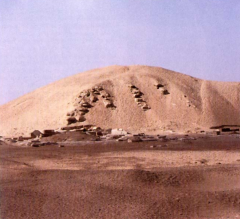
|
Pyramid of Senwosret I, el‐Lisht, Dyn. 12
• Senwosret I pyramid: badly preserved mortuary temple and causeway, valley temple not excavated. • Pyramid designed with a star‐ shaped skeletal structure then filled in with unworked stone and stone stolen from Giza. •It fell apart when the outside casing stones were robbed in the Medieval period. |
|
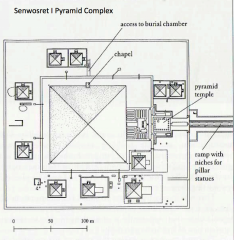
|
Senwosret I Pyramid Complex; el-Lisht; Dyn 12
Decorated with mummiform statues of King - similar mortuary temple plan to OK - unique inner enclosure wall: decorated with panels showing king's serekh with Horus wearing double corwn and fecundity figure - walls indicate that they start to want privacy
|
|
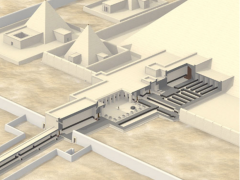
|
Senwosret I Pyramid Complex; el-Lisht; Dyn 12
- niches would have statues - inner enclosure wall would have been decorated with the Serekh |
|

|
Limestone panels from inner enclosure wall, pyramid complex of Senwosret I, Lisht, Dyn. 12
- horus carved in high relief, wears double crown - king's horus name + alternating throne name and given name - palace facade below - fecundity figure: represents prosperity of Egypt |
|
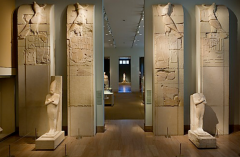
|
Limestone panels from inner enclosure wall, pyramid complex of Senwosret I, Lisht, Dyn. 12
- horus carved in high relief, wears double crown - king's horus name + alternating throne name and given name - palace facade below - fecundity figure: represents prosperity of Egypt |
|
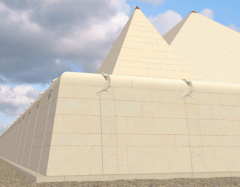
|
Limestone panels from inner enclosure wall, pyramid complex of Senwosret I, Lisht, Dyn. 12
looks like the fecundity figures are walking around the perimeter of the pyramids |
|
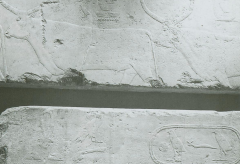
|
Pyramid of Senwosret I, el‐Lisht, Dyn. 12
- resources belonged to 4th dynasty Kings (Khufu’s) |
|

|
Mummiform statue of Senwosret I, pyramid complex at Lisht, Dyn 12
- from niches carved into interior walls of causeway - arms are crossed across the chest |
|

|
Raised relief showing offering bearers, offering chamber, funerary temple of Senwosret I, Lisht, Dyn 12 |
|
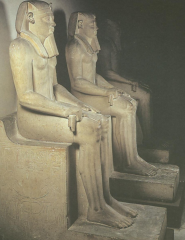
|
Statues of Senwosret I, pyramid complex of Lisht, Dyn 12
Pronounced musculatore (back to OK style) but no cankles) - these stautes were found in a pit outside the temple, maybe he didn't like their youthful appearance |
|
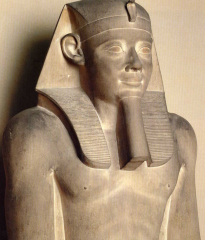
|
Statues of Senwosret I, pyramid complex of Lisht, Dyn 12
possible he died much older so his youthful appearance in these statues may not be a true representation of him |
|
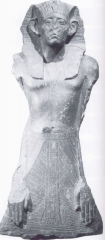
|
Statue of Senwosret III from funerary temple of Montuhotel II, Deir el Bahari
- face looks aged, body does not - he's in a suppliant pose (worshiper) |
|

|
Pyramid of Senwosret III, Dahshur, Dyn 12 - completely of mudbrick, but faced with limestone - N/S orientation - 12 princesses buried around pyramid, all intact |
|
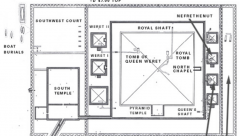
|
Pyramid of Senwosret III, Dahshur, Dyn 12
love of walls for protection - although it's mainly N/S, there's a mix of E/W as well |
|

|
Senwosret III's red granite sarchophageus; Dahshur; Dyn 12 |
|
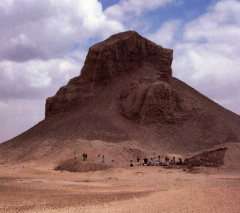
|
Pyramid of Amenemhat III, Dahsaur, Dyn 12
- called "black brick pyramid (core of brick and limestone facing) - only used for burial of queens and princesses - King was buried in Hawara - with one of the princesses is King hor from dyn 13 |
|
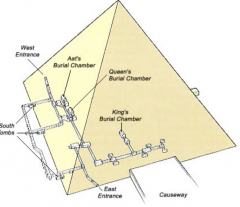
|
Pyramid of Amenemhat III, Dahsaur, Dyn 12
Added mazese and dead ends to keep ppl out it didn't work, it was still robbed |
|
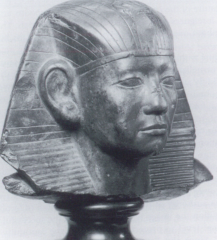
|
Head of Amenemhet III
- resembled his father
|
|

|
Pyramidion of Amenemhet III; Dahshur, Dyn 12
decorated with King's eyes: he observes the journey of the sun in teh sun barques |
|
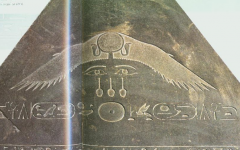
|
Pyramidion of Amenemhet III; Dahshur, Dyn 12 (specifally the King's eyes)
these are the King’s eyes were he can look out and survey the land |
|
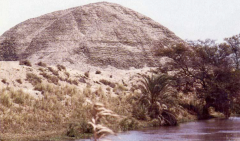
|
Pyramid of Amenemhat III, Hawara; dyn 12 built after pyramid at Dahshur (limestone brick) - extensive complex of chapels and courts around it (like a Labyrinth) |
|
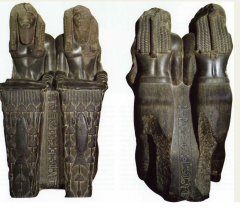
|
Double figure of Amenemhat III, Tanis (originally Hawara), dyn 12 - pictured as god of the Nile - fish offering state hairtstyle is unusual-> thick braids and shield shaped beards - symmetry of two states refelct dualism of Upper and Lower Egypt |
|

|
King Hor, 13 D, Ka stature (and body) found in burial shaft with Amenemhat III's daugher |
|

|
Relief; FIP; elite
Intermediate style: huge eyes, very high raised relief that is modeled, men slender, un-muscled |
|
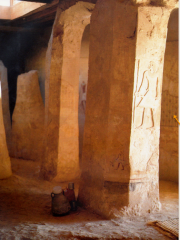
|
Rock Cut mastaba; FIP; elite
- coloumns were carved out of the rock |
|
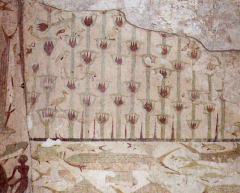
|
Papyrus thick; elite tomb; FIP
- in old Kingdom, no overlap - scale is dependent on the importance of the scene or who is in the scene (fish are not to scale and there is no overlap (allows fish expects to determine what time to fish it is) |
|
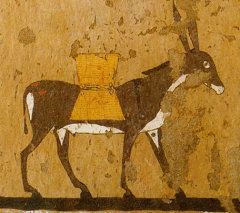
|
FIP; "folding" perspective
Donkey carries two wicker baskets on either side of his back, but the one on the other side is flipped up so we can see it! |
|
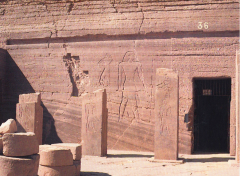
|
Rock cut tomb; elite; modelled after royal tombs; MK
- scenes of everyday life drawn on the front |
|
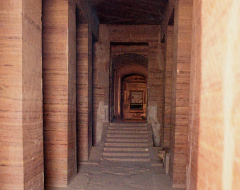
|
elite tomb; MK
funerary repast scene |
|
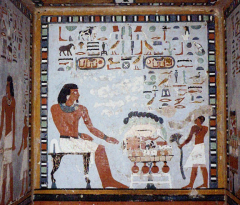
|
Return of the traditional repast scene; MK
Amenemhat II cartouches twice. Elephant heiroglyph |
|
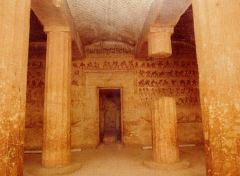
|
Again, domestic architecture being copied in stone: all carved out of solid rock, not put together. Vaulted ceiling Focus on statue niche in center with Amenemhat, his wife and his mother |
|
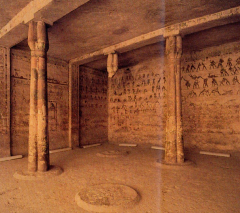
|
elite tomb; Beni Hasan
Two rows of three columns, in form of bunches of lotuses - not functional supports |
|
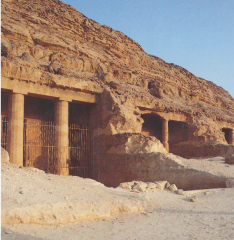
|
Portico façade, tombs at Beni Hasan, Dyn. 12, ca. 1930 BCE Tomb architecture borrowed from houses: porch with columns=wooden veranda. Ceiling beams are even imitated, sticking out. |
|
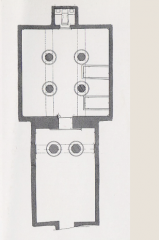
|
Floorplan of tomb of Amenemhat, Beni Hasan, Dyn. 12,
Statue niche--> Burial chamber (off to the side)--> Columned portico--> Outer court |
|
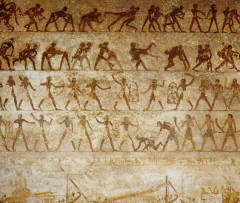
|
Wall painting; Beni Hasan; MK
59 pairs here, sequences of movements Opponents are in two different tones of brown so yu can see them Egyptian soldiers and Libyans with colorful kilts and beards Journey to Abydos: oldest depiction of this=trip to Osiris’ tomb |
|
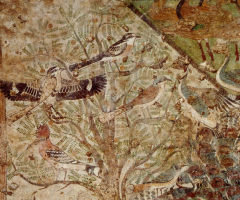
|
Wall painting; Beni Hasan; MK
Individual birds can be easily recognized. Complexity of the scene, but harmonious |
|

|
Wall painting of special event; Beni Hasan; MK
- special events in someone’s life - group of men (called Hyksos) from the far east that are known that took over the Delta in the 2nd intermediate period (different style of beard and dress) and they are bringing gifts to a nomarch |
|
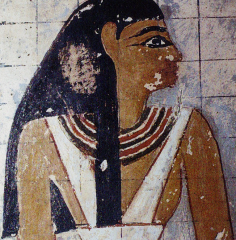
|
relief with gridlines; elite; MK
Grid lines used as a guide, but never precisely. Provided a general orientation - allowed regularity to wall painting |
|
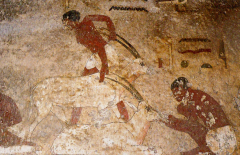
|
Wall painting; MK; elite
- completely painted (no relief) |
|
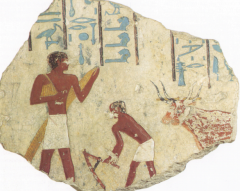
|
Painted relief; MK; elite
when trying to do a rock relief, we get more static pictures |
|
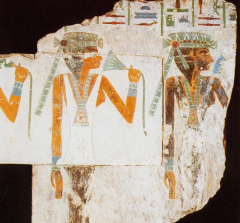
|
Painted rock relief; MK; elite
very thin relief, almost flat. Stiff stances. Fashionable wigs. |
|
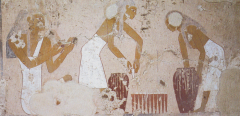
|
Wall painting; MK; elite
- justaposition between relief and paintings - they are painted but they looked stiff - -they are painted but they looked stiff |
|
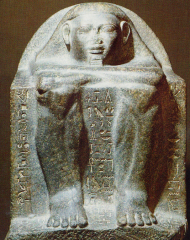
|
Cuboid statue; Dyn. 12, MK
daytime journey of the sun - in the MK, we get new ways to expressing connections to the afterlife |
|
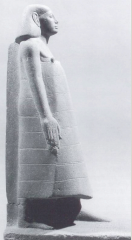
|
Standing statue of elite in garment
very different from previously traditional garb (kilt) - connection with the new government position (position requires a different dress) |
|
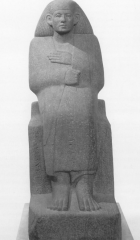
|
Seated statue of elite in enveloping garment, late MK
• Face: non-idealized, represents mature official, derived from Senwosret III and Amenemhat III - might have to do with the person’s rank
|
|
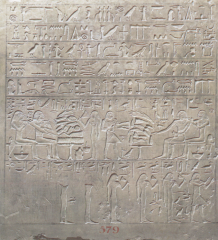
|
Unfinished stealae of sculptor; MK; elite
in MK, we get more family orientated sculptures, stelae, relief • Offering formula, prayer to the living (asking for things) • He has two wives... polygamy? • Also includes his parents on the right. |
|
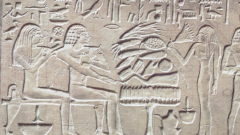
|
Unfinished stealae of sculptor; MK; elite
- 14 blocks when you’re seated |
|
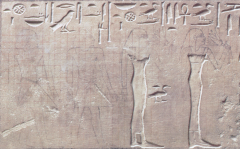
|
MK; gridlines
Although they are all 18 grid squares tall, they are still not exact replicas...small of back at different heights. |
|
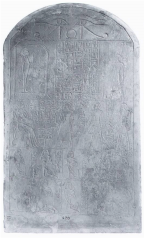
|
elite; steale; MK
- an elite person depicting God alongside themselves - located at Abydos (marker for this person’s presence at Osiris’s tomb) |
|
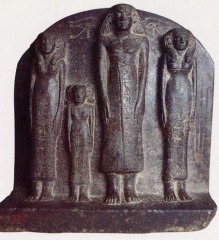
|
Group statue; elite; MK
• Two wives and daughter. • Wedjat eyes. |
|
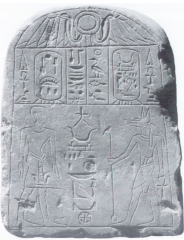
|
Stealae of King in Dyn 13
• He must have lacked resources, very crude style and small. • Winged sun disk with uraei (cobras). • Hieroglyphs have his four names. |
|
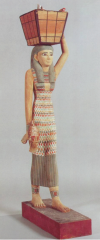
|
One of pair of model offering bearers; MK; elite
• Descendents of female personifications of estates from OK pyramid complexes and private tomb chapels. |
|
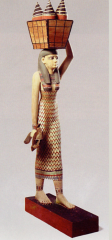
|
One of pair of model offering bearers; MK; elite
The other, carries duck and drinks: jars sealed with conical lumps of clay |
|
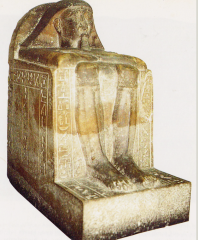
|
Cuboid statue; MK; elite; nighttime journey of the Sun
• One of the earliest of this type |
|

|
Very elaborate tomb model; elite; MK
cattle count for tax purposes. Scribes, officials, the deceased on platform; delinquent herdsman being flogged! |
|

|
Very elaborate tomb model; elite; MK
bread making |
|
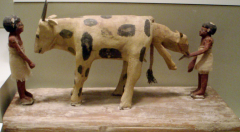
|
Very elaborate tomb model; elite; MK
cow birth scene that was drawn in 2D in OK and now made in 3D in MK |
|

|
Shabti; elite tombs figurine; MK
They are “answer figures” who must respond to their master’s order to work and take upon themselves unpleasant tasks. They represent the owner of the tomb, not a separate servant. |
|

|
Apotropaic “rod” with protective animals. Intended to be used by both the living and dead - symbolizes with the sun being reborn; we associate with this because we’re supposed to be reborn into the afterlife |
|

|
Apotropaic “wand” with deities, animals, fanstic creatures.
looks like a boomerang |
|
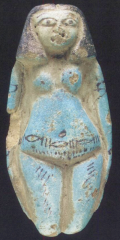
|
Fertility figurine of faience, Thebes, Dyn. 12-13,
used by living and dead for notion of fertility and family continuity. Also protection of dead as they are reborn into the next life. - there's protective writing on them |
|
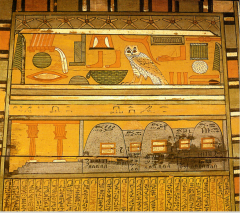
|
elite coffin; MK
This is the foot- end of the interior of the coffin-the exterior only painted in hieroglyph bands. Here: coffin texts, storage silos, columned front hall, heavens (stars) - hieroglyphs says "Isis at your feet" |
|
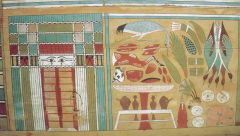
|
MK; Interior of outer coffin of elite, false door at north end facing east, Bersha, cedar wood, Dyn. 12
deceased would have been facing this door (facing east towards the rising sun) |
|
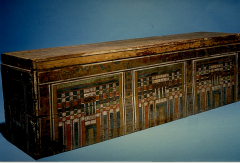
|
more elaborate exterior of coffin; MK; elite
|
|
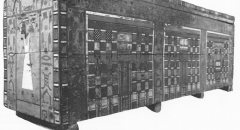
|
coffin; MK; elite
Isis’s sister is on the other side (Isis is on this side) |
|
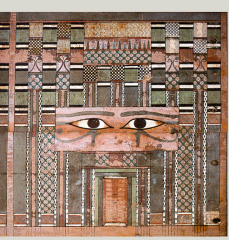
|
elite; MK
coffin as home: architectural details, base and posts of the wooden home, doors with two leaves, finely patterned mats. (wedjat eyes) |
|

|
Inner wooden coffin of elite, wedjat panel on north end of east side, Dyn. 12-13, |
|
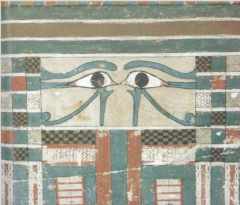
|
coffin; elite; MK
Wedjat eyes allowed deceased to look out from the coffin towards the rising sun and land of the living |
|

|
New form of coffin towards end of MK: Anthropoid Becomes very important in New Kingdom
- we will never find JUST the anthropoid coffin—> it will be placed in the rectangular coffin (the house) |
|
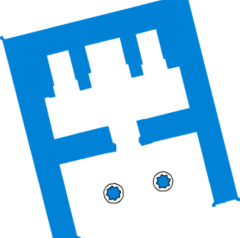
|
basic temple plan: entrance porch (open section with supporting columns), offering chamber, cult statue niches walls are all decorated with images |
|

|
Scene from king’s chapel, Montuhotep II, Dendera, Dyn. 11: legitimization of rule
vulture goddess holding the symbol of life above the King, protecting him flail is a the divinity of kingship
|
|
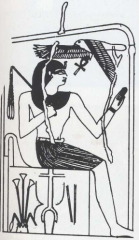
|
Scene from king’s chapel, Montuhotep II, Dendera, Dyn. 11: legitimization of rule
vulture goddess holding the symbol of life above the King, protecting him flail is a the divinity of kingship |
|

|
Mentuhotep II – 11th D., Armant state temple – King before goddess Yunit, companion of Montu; interaction between king and gods
- similarity of facial feature between the king and goddess (god is remodelled to look like the King)… s way to visually connect the tw
|
|
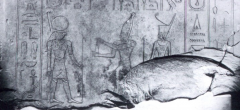
|
Nebhepetre Mentuhotep with the god Montu and goddess Neith (wears red crown—main cult place in Delta).
King giving gifts to gods: performing rituals |
|
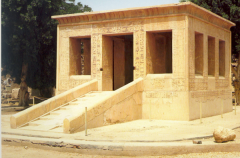
|
"White Chapel"/ barque shrine of Senwosret I, Karnak, Dyn 12
not much of MK contributions of temple in Karnak is left… we only have this boat shrine… this is our best guess of what happened here (we actually don’t know for sure what happened here)
4 pillars on each outside, 4 pillars on each side of the inside. Two ramps on either side.
Reconstructed from small blocks found around the site |
|
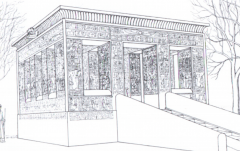
|
"White Chapel"/ barque shrine of Senwosret I, Karnak, Dyn 12
- fully covered in king interacting with gods with hieroglyphs describing the situation |
|
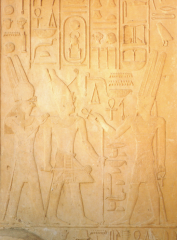
|
Amun-Re offering life (ankh) to Senwosret I, embraced by Montu – White Chapel – Karnak temple
Located on one of the pillars inside the White Chapel. Inscription says this takes place in conjunction with king’s festival of renewal. =cultic perpetuation of this act; built during his sed festival year |
|
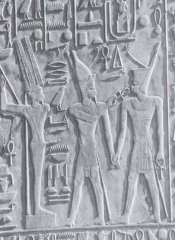
|
Atum offering life (ankh) to Senwosret I, Standing statue of Amen-Min/Ra – White Chapel - Karnak
Very high relief and subtly modeled (notice stomach muscles and legs) |
|

|
Karnak block with statue niche of Amen-Re offering life to Senwosret I – Karnak temple
Notice difference in carved relief styles: surface is less modeled and few details incised. Two royal workshops perhaps? |
|

|
Obelisk of Senwosret I – red granite – Heliopolis Atum temple – for sed festival
We know that MK Kings built temples in other cult centers, but we have very little left. ! |
|

|
mummiform pillar statue of Senwosret I – Karnak temple
Found reused at Karnak in foundations of the sixth pylon (gate) built during 18th D. Still has some elements of the FIP period: cosmetic lines and fleshy nose and large lips. =connection to Osiris |
|
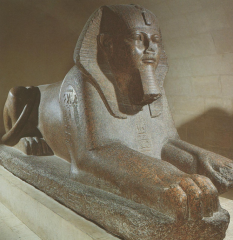
|
Sphinx of Amenemhet II
king’s nature as deity (being able to transform from a human body into an animal (lion)) |
|

|
Statue of Senwosret III from Hierakonpolis, Dyn. 12,
- when he was younger (more youthful looking) |
|

|
“Priest” figure of Amenemhet III –12th D
•Found at Shedit: cult site of crocodile god Sobek. •Up against wig : two narrow divine staves with falcon heads= prototype for royal staff bearer statue type in NK •Must be statue referring to a particular cult ritual |
|
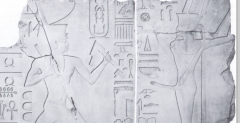
|
Senwosret I and Min, Coptos
King performing cult activities: running the boundaries |
|
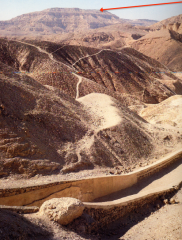
|
"Horn of Qurna” Highest elevation in the valley (450m) Became the “pyramid” for royal tombs in the Theban valley - Kings are now located in Thebes - tombs were buried deep into the cliff |
|

|
Hatshepsuts mortuary temple at Deir el Bahari, Thebes (Montuhotep II’s is next door) |
|
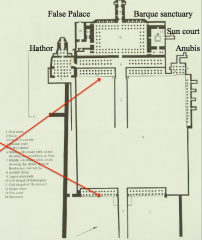
|
Mortuary Temple of Hatshepsut at Deir el Bahari
Oriented toward the west • Three ascending terraces or levels • Large front courtyard with pools, trees • Two halls: representations of ruler’s guarantee of a cult, mythic and real. • Lower terrace: second courtyard with pillared halls • Divine lineage of Hatshepsut, expedition to Punt • Upper terrace: altar, false palace for ancestors and sun court for Re-Horakhty |
|
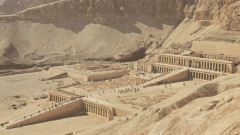
|
Mortuary Temple of Hatshepsut at Deir el Bahari |
|
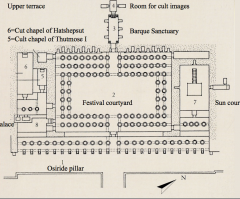
What is this? |
Upper terrace, Mortuary Temple of Hatshepsut at Deir el Bahari |
|
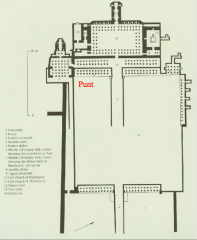
|
Mortuary Temple of Hatshepsut at Deir el Bahari
one of the most famous carving is the carving along the second open court towards the South— expedition to Punt |
|
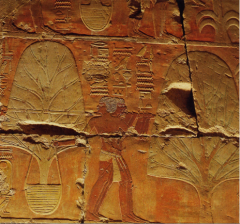
|
Punt- place where ppl would travel for months and bring gold, animals, leather skins, inscents things you can’t get from Egypt
Transportation of myrrh trees |
|
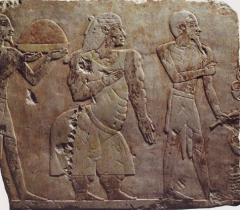
|
Punt- place where ppl would travel for months and bring gold, animals, leather skins, inscents things you can’t get from Egypt
King and Queen of Punt |
|
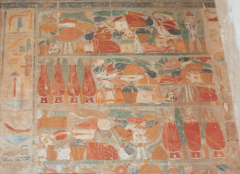
|
Mortuary Temple of Hatshepsut at Deir el Bahari
Table of Offerings from Anubis chapel – middle terrace, north side |
|
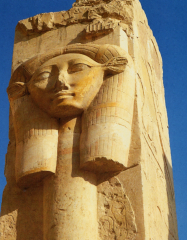
|
Hathor column, from Hathor Chapel – middle terrace, south side Hathor: godess of Western Thebes Modeled after a “sistrum”: musical instrument used to appease the gods; especially associated with Hathor’s cult
Hatshepsut's mortuary complex; Dyn 18 |
|
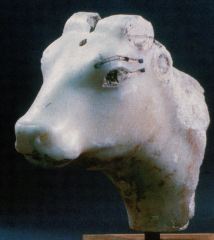
|
Inlaid Hathor head from cult statue in the Hathor chapel (within Hatshepsut’s mortuary temple) made of alabaster once part of a cult statue of Hathor manifested as a cow. Eyes inlaid with rock crystal and lapis lazuli (blue).
Hatshepsut's mortuary complex; Dyn 18 |
|
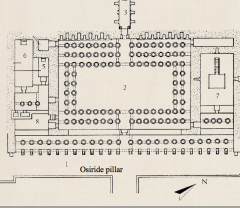
What are the features (in terms of art)? |
1) Osiride pillar 2) found most the fragment of statuary here; images of the King performing offerings throughout this cult area
Hatshepsut's mortuary complex; Dyn 18 |
|
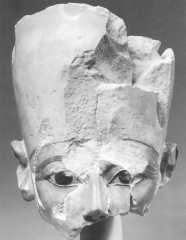
|
Hatshepsut; Fragment of Osiride pillar statue, originally fronting pillars of upper court
- very life like, modelling of the nose (made of stone); high artistry (like OK) but maintained some features of MK |
|
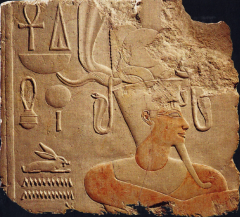
|
- images of her father, Thutmose I (in upper terrace, offering to AmenRe) |
|

|
Enthroned Hatshepsut as a woman with nemes, red granite
- very feminine looking (wears a dress) except for the head dress that’s a king’s |
|

|
Enthroned Hatshepsut, perhaps from mortuary cult place on upper terrace
Wearing ceremonial costume of a reigning pharaoh. Unites her official status in an ideal manner with physical form of a woman. May have been originally situated in room for mortuary cult offerings. |
|
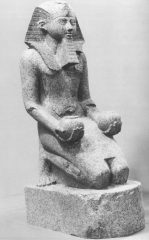
|
- this is Hatshepsut depicted as a male
One of eight that were set up in the upper court to line the way to the entrance of the sanctuary. She offers two nu-jars, associated with the offering of wine. Gesture can also symbolize the notion of offering |
|
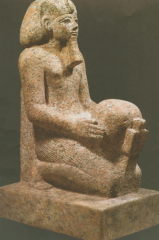
|
Kneeling Colossal Hatsepsut, offering to gods a water jar, one of 8 in Upper Terrace lining entrance to sanctuary |
|
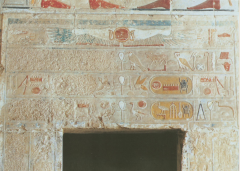
|
Statue niche with removal of Names (Hatshepsut)
- her co-regent (step son) has some issues |
|

|
Hypothetical plan of the mortuary temple of Amenhotep III
- we know the footprint and where the pylons were (the monumental gate) |
|
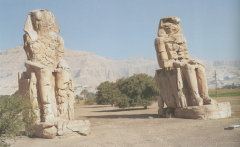
|
"Colossi of Memnon – Mortuary temple of Amenhotep III
- only things standing at the mortuary temple of Amenhotep III - ppl believed these two statues were of memnon and not the King (amenhotel III)…. when the sun rose, the statue will start to squeak… so they think when the sun (so when Eos came up) and the statue starts “crying” (what ppl taught the |
|
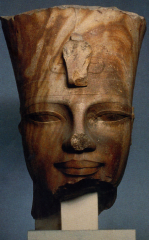
|
Colossal quartzite head of Amenhotep III wearing red crown – one of 18 statues on North side of great sun court
Facial features show characteristic traits for Amenophis III: almond-shaped eyes with band for upper eyelid, broad- ridged small nose, full mouth with sharp ridge. - mid 18th D, simplification of features again |
|
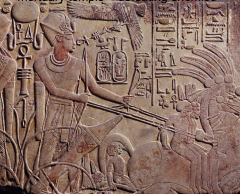
|
Stela of Amenhotep III from sun court of his mortuary temple
- blue crown- war crown |
|
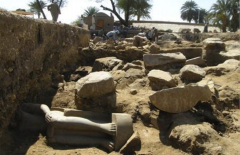
|
statues of Amenhotep III |
|
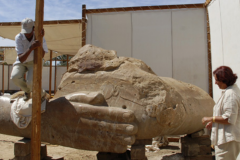
|
colossal statue of Amenhotep III from Kom el Hetan |
|
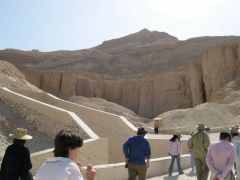
|
Entrances to the tombs at the "valley of the Kings" would have been covered in the dirt |
|

|
Entrances to the tombs (they were originally hidden) |
|
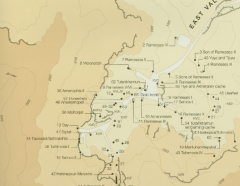
|
- plan of the tombs that we have found so far in Valley of the Kings
|
|

|
Plans of 18th D royal tombs; valley of the kings
18th Dynasty tombs are relatively small compared to those from Horemheb onwards(19th/20th Dynasties)%
corridor height in 18th D= 2m; ramesside 4m
Right angle turn in axis of 18th D symbolized winding path through the underworld |
|
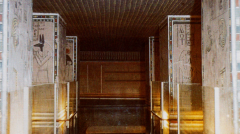
|
burial chamber of Amenhotep II
Made of look like stretched papyrus parchment - relatively simple |
|
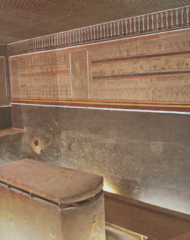
|
Burial chamber of Amenhotep II
painted to look like papyrus is being glued on to the wall (and looks like the drawings are drawn on papyrus) Amduat displayed on the walls in the form of a series of registers and sections, each depicting one hour out of 12 that the sun god has to pass through |
|
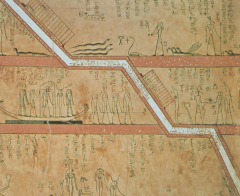
|
Hour 4 from the Amduat-- tomb of Thutmose III |
|

|
Hour 6 from the Amduat-- tomb of Thutmose III
- merges with his ba (or with Osiris’s soul, depends on the version) |
|

|
Hour 7 from the Amduat-- tomb of Thutmose III
this is Apopsis (the huge enemy)
Osiris thanking the friends for protecting Ra (of the 12 hrs)
|
|
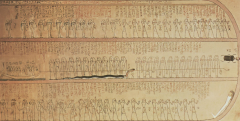
|
Hour 12 from the Amduat-- tomb of Amenhotep III
Ra gets out of boat, transforms into a snake, then a bettle, and that’s how he’s reborn into the eastern sky
amenhotep waiting for the Ra to be reborn so he can too be reborn |
|

|
Antechamber of Tomb of Thutmose IV
- repeated king with different deities (interaction with the Gods) |
|
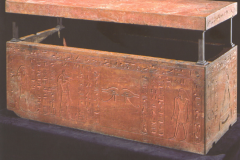
|
Sarcophagus of Thutmose I (early D. 18)
- simple, square boxes, probably an anthropoid inside (they could be taken away while sarcophagus are heavy) |
|
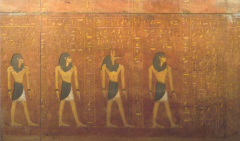
|
Sarcophagus of Thutmose IV- mid d18 - canopic gods |
|

|
Relief of King Tut at Luxor
he reigned for a while before he mysteriously died at some point early in his life (speculated that he was in a chariot accident but the mummy doesn’t show this) |
|
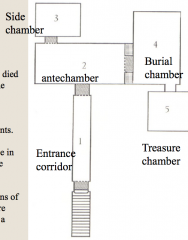
|
Plan of the tomb of Tutankhamen, Valley of the Kings
Tomb was not proper because he died early and unexpectedly (many of the items not made for him originally) |
|
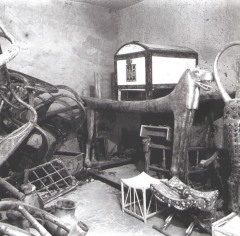
|
tomb of Tutankhamen, Valley of the Kings ante- chamber of Tutankhamen during excavation ...more like removal |
|
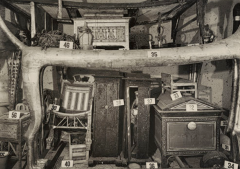
|
tomb of Tutankhamen, Valley of the Kings
ante- chamber of Tutankhamen during excavation ...more like removal (some things were those he used, some were bought just for him) |
|
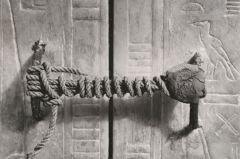
|
tomb of Tutankhamen, Valley of the Kings
The second shrine: - seal was a lump of clay with a stamp on it… indication whether it was tampered with |
|
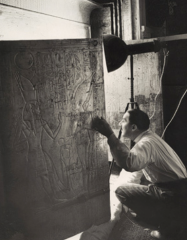
|
tomb of Tutankhamen, Valley of the Kings
Howard Carter opening it for the first time, 1924 (second shrine) |
|

|
tomb of Tutankhamen, Valley of the Kings
2nd of 4 wooden shrines containing the body
the doors are covered in Gold |
|
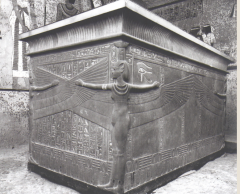
|
Quartzite sarcophagus of Tutankhamen
- stone sarcophagus |
|
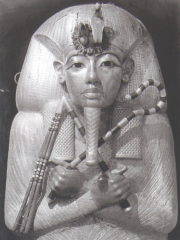
|
King Tut's outer coffin
3 anthropod coffins
|
|

|
King tut's middle coffin
middle coffin was covered with a cloth, and covered with ointments, fragrances, garlands, etc. |
|
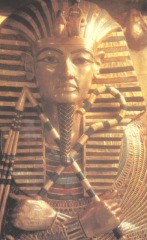
|
King tut's middle coffin (after you take away the ritual items)
middle coffin was covered with a cloth, and covered with ointments, fragrances, garlands, etc. |
|
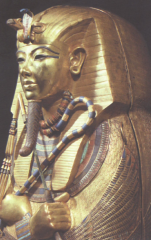
|
King tut's inner coffin
inner coffin is made of gold |
|

|
King tut's inner coffin
inner coffin is made of gold |
|
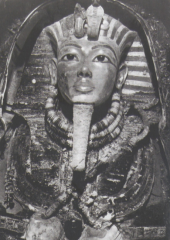
|
Gold mask of Tutankhamen
- the ointments degraded the mummy |
|

|
Gold mask of Tutankhamen
writing on the back compared his facial features with the gods (for relativeness) |
|
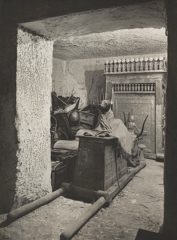
|
- canopic shrine of kIng tut
|
|
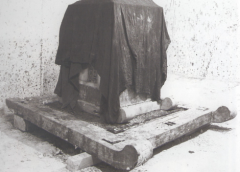
|
King Tut's Canopic shrine and inner calcite canopic chest
Purpose: keep organs intact (mummified) Calcite alabaster was used for the chest |
|
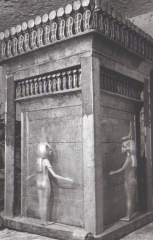
|
King Tut's Canopic shrine and inner calcite canopic chest
Purpose: keep organs intact (mummified) Calcite alabaster was used for the chest |
|
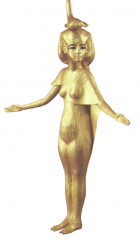
|
King Tut's Canopic shrine and inner calcite canopic chest
Image of protective goddess Selket from canopic shrine |
|
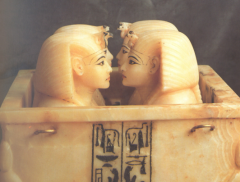
|
King tut
Calcite inner canopic chest with four lids, bearing face of king
heart, lung, intestine, stomach |
|
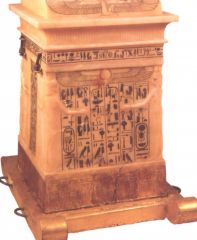
|
King tut
Calcite inner canopic chest with four lids, bearing face of king
heart, lung, intestine, stomach |
|

|
King tut 1 of 4 Canopic coffins for lungs, stomach, liver, and intestines |
|
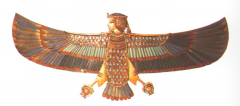
|
Ba bird amulet of Tutankhamen Found on the linen bandages of the mummy. Holds shen rings. The ba was an aspect of human existence: ba soul could leave the tomb in form of a bird and contact the living world, then return to the mummy. |
|
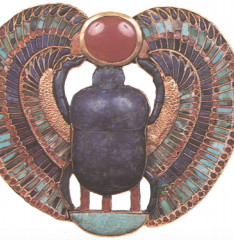
|
Scarab pendant of spelling the name Neb-kheperu-Re
"Lord of the Manifestations of Re"= his throne name. winged scarab was also the sign of the morning sun god Khepri=integration of the king and the cyclical course of the sun |
|
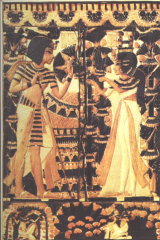
|
Chest of Tutankhamen
him and his wife when he got married (he was married as a child) |
|
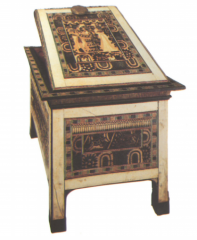
|
Chest of Tutankhamen
him and his wife when he got married (he was married as a child) |
|
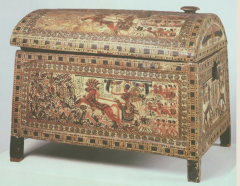
|
King tut's sandal chest
king and ordered army against the chaos of the enemies around them (this is a sandal chest) - not a real battle |
|
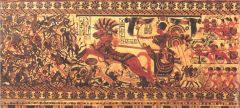
|
Sandal chest of Tutankhamen – with scenes of war on one side and hunting on the other - not a real battle (shows theme: order vs chaos) |
|
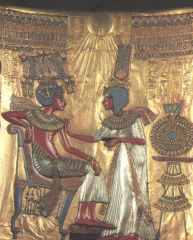
|
Throne of Tutankhaten (original name of Tutankhamen) |
|
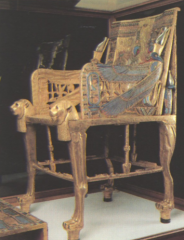
|
Throne of Tutankhaten (original name of Tutankhamen) |
|
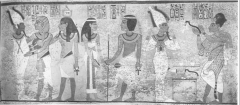
|
North wall in burial chamber of King Tutankhamun.
King Ay, his successor shown performing the opening of the mouth ritual on the mummy; also Tutankhamun with his Ka welcomed into the underworld by Osiris |
|
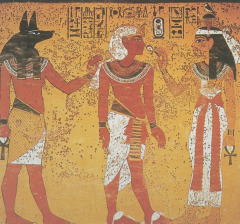
|
South wall of burial chamber of King Tut
Tut with Hathor and Anubis. Similar style, but different artist |
|
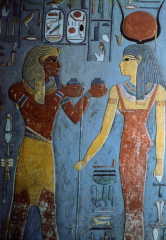
|
Horemheb's tomb
Horemheb offering wine to Hawthor flat, monochrome, colour blocked style |
|

|
Burial chamber in tomb of Horemheb. Incomplete images in the pillar room clearly reveal the working method employed: red-lined preliminary drawings with corrections in black. Progressed from bottom to top. Final stage was painting
- weird: he lived long enough to complete it |
|
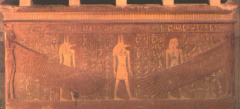
|
Sarcophagus of Horemheb- late d18
Now customary to show protective goddesses Isis, Nephthys, Selket and Neith with wings on corners in addition to canopic gods. |
|
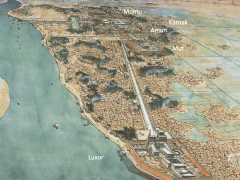
|
- the three triad gods: Montu (war god), underneath Montu’s temple is Amun, Mut’s temple is beneath Amun’s |
|
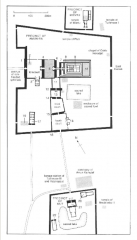
|
Karnak Temple - 3 precinct: AmenRe (main precent), Mut (consort, South), Montu (north) - began in MK - expanded considerably in D18 - wealthy administrative center of Theban region |
|
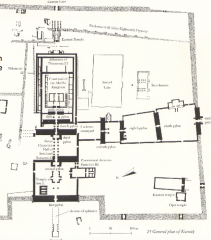
|
Important feature: Began with East-West axis; North-South axis created over time with adding more and more pylons
temple has multiple pylons (it’s a gate way) |
|

|
Sacred Lake at Karnak Temple |
|
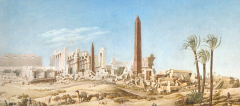
|
View of Karnak during the Napoleonic campaigns |
|
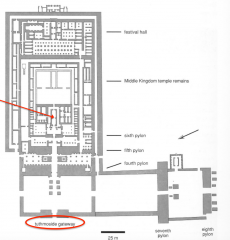
|
Karnak during the reign of Thutmose III
Arrow: Possible site of Amenhotep I’s Alabaster Chapel
Circle: pylon dates to king Thutmose III’s reign (made of two parts: amenhotep built the first part, thutmose III did the second part) |
|
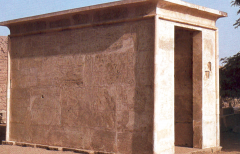
|
Alabaster barque shrine of Amenhotep I
Started by Amenhotep I, finished by Thutmose I, blocks reused in Amenhotep III’s Third pylon |
|
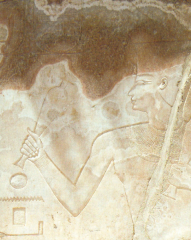
|
image of Amenhotep I on his alabaster chapel. Shown participating in a cult procession. Distinctive portrait: large, hooked nose with smaller eyes, ears, mouth and chin. Diverged from the harmonious ideal in fashion at the time - distinctive portrait doesn't translate to statuary art |
|

What did Thutmose I add?
What is the red arrow pointing to? |
Arrow: Hatshepsut's obelisks
Thutmose I added: fifth, fourth and column hall between obelisks in front of fourth, surrounded area with an enclosure wall |
|
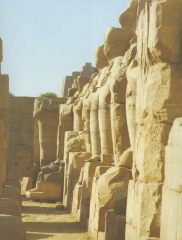
|
Hypostyle hall of Thutmose I. Between the 4th and 5th pylons.
Carved from sandstone, 5m high.
36 Osiride pillars stood along the walls in deepened niches. |
|
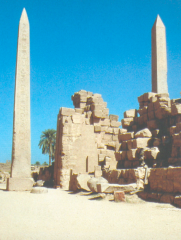
Who's obelisk on the left, right? |
Obelisks of Thutmose I (in front of 4th pylon) and Hatshepsut (5th pylon). Red granite.
Thutmose I’s had gold on the top and Hatshepsut’s had electrum (mix of gold and silver).
left: southern one of Thutmose I
right: Hatshepsut’s |
|
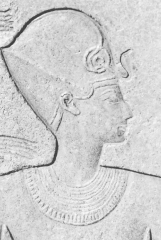
|
Hatshepsut, detail from top of one of her obelisks, placed in Thutmose I’s (her father’s) hypostyle hall.
Distinctive profile with very prominent nose (Thutmose III, her co-regent would do the same) |
|

|
Block from Hatshepsut’s “Red Chapel”. Originally located in front of central shrine of Amun-Re for his barque. Long sides of chapel tell of the dedication of the obelisks and the sanctuary.
dedicated to the sanctuary and Gods, Amun, how he’s so great, and why Hatshepsut should be legitamized |
|
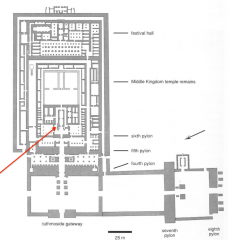
Red arrow? |
Location of the original “Red Chapel” aka barque shrine of Hatshepsut |
|
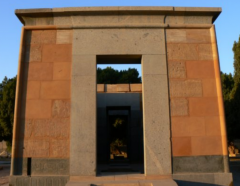
|
Red Chapel of Hatshesut
- the smooth stones are “fake” |
|
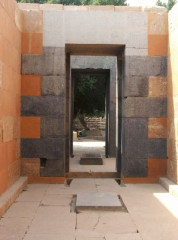
|
Red Chapel of Hatshesut
the different coloured stones are intentional |
|
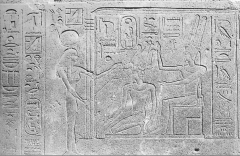
|
Red chapel of Hatshepsut – quartzite – coronation - Karnak
Hatshepsut kneeling before Hawthor and Amun Hawthor pushes ankh symbol to her nose, Amune gives her the crown (to legitimize her... Egypt is her's to rule) |
|
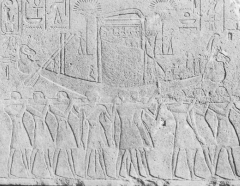
|
Red chapel – Opet Festival
god on boat, carried by ppl from Karnak to Luxor |
|
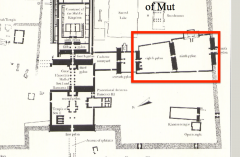
|
Hatshepsut’s extension North-South to temple of Mut |
|

|
8th pylon of Karnak built by Hatshepsut
She extended a series of pylons north- south axis leading to the temple of Mut - pylons - usually smiting scenes on these, or king interacting with the gods |
|
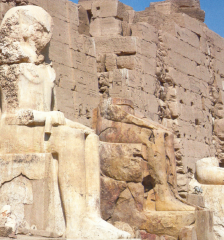
|
Southern façade of Hatshepsut’s Eighth pylon with colossal figures of herself. Six total seated figures, very badly damaged. Statues of Hatshepsut, Thutmose III and some predecessors |
|
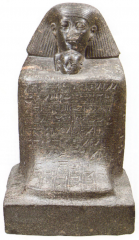
|
Hatshepsut's teacher (Senenmut) - there's a lot of art of them in Hatshepsut's mortuary temple and at Karnak - his name was eventually erased from the statues (Hatshepsut and the teacher ended up hating each other
|
|

|
Hatshepsut's teacher (Senenmut) and Hatshepsut - Karnak |
|
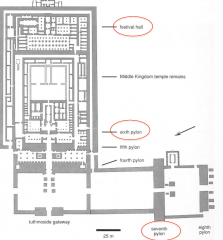
Who made these innovations? |
Karnak
Thutmose III: added 6th pylon, more columns in Thutmose I's hall, added 2 more obelisks in front to 4th pylon, built seventh pylon and added another pair of obelisks, festival hall |
|

|
Akhmenu Sed Festival hall of Thutmose III, Karnak Built to the east of the inner sanctum of temple of Amun. Name refers to this establishment’s function as the place of “transfiguration” where divine and royal power combine |
|
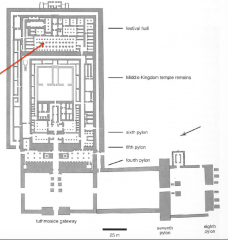
Arrow? |
Akhmenu festival temple |
|

|
Botanical scene – Thutmose III- festival hall; Karnak
- important because we’ve never seen plants drawn |
|
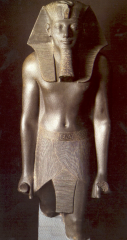
|
Standing statue of Thutmose III – from Karnak sed festival hall
Classical standing pose with left foot forward. Extremely high quality and symmetry of proportions, surface treatment and classical musculature |
|
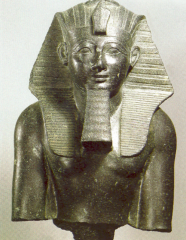
|
Thutmose III (karnak?)
in different style, less ideal (small features are there) |
|
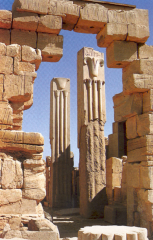
|
Emblematic columns of Thutmose III – Karnak – red granite in front of barque shrine
He redesigned the central section of the temple of Amun in this final year of reign
In front of the barque sanctuary he erected two monuments: the “emblematic columns”
Northern and southern sides they have raised relief of papyrus and lotus (shows the regeneration and that the world came up from this mound; the King is building things that are lifting life from the ground because he’s going what he should be going).
|
|
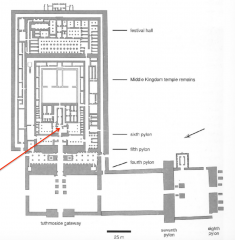
arrow? |
Tutmosis III’s Emblematic columns ; Karnak |
|
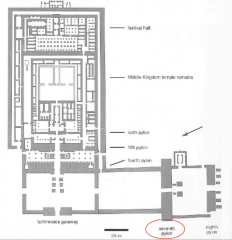
|
Thutmose III added another pylon, the Seventh, in front of Hatshepsut’s (Eight) and two giant statues of himself in front of them. - as you come from the North, you see Thutmose III's statues |
|
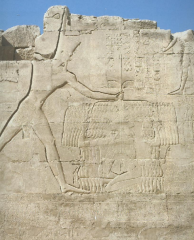
|
7th pylon – smiting motif of Thutmose III symbol to ward off evil |
|
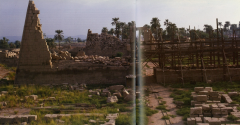
|
Ninth and Tenth pylon built by Horemheb Stones in front are parts of older buildings that have been taken out by archaeologists. They will then rebuild the pylon (scaffolding).
Karnak |
|
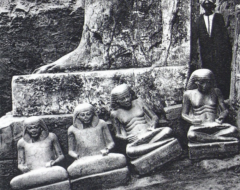
|
Private scribe statues found at Horemheb’s Tenth pylon: - Paramessu= Vizier (also= King Ramesses I)
Used as mediators between humans and gods (scribes are the ones writing sacred texts… which means they have direct contacts with the Gods ) |
|
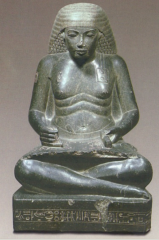
|
Statue of Amenhotep son of Hapu Reign of Amenhotep III • Granodiorite • N-SaxisofKarnaktemple • “Leader of the Festival” at Karnak • After he died he was deified and worshipped as the god of medicine: this statue had “powers”, smooth polish in middled of rolled papyrus meant people were rubbing it. |
|
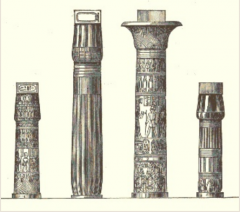
|
NK columns-- they have order (i.e. there are different types); all modelled after representations of papyrus (depicted in stylized form)
papyrus bud, papyrus bundle, open papyrus umbel, bud bundle |
|
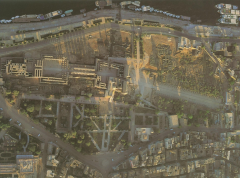
|
Luxor Temple; well preserved |
|
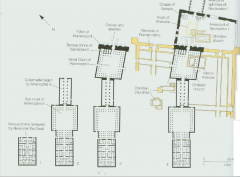
What was the luxor temple also used for? |
Luxor Temple
- during roman period, it was used as a fortress and military camp (Roman headquarters for the south) |
|
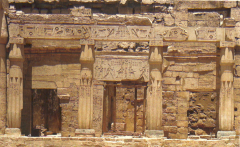
|
Thutmoside Triple Barque Shrine- Luxor
Temple: papyrus columns date to Hatshepsut because some adjectives are still in the “feminine” form // they forgot to change the gender when Ramasses II started building the peristyle court around it |
|
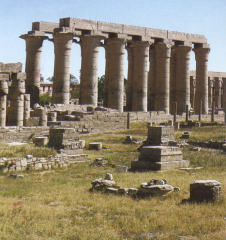
|
Colonnade hall of Amenhotep III – open papyrus columns – Luxor Temple
Amenhotep III replaced the main Thutmosid temple with an enormous new building with an elaborate colonnade entrance hall: two rows of seven open papyrus columns 21 m high. Would have originally been closed on top and on the sides |
|
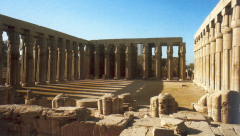
|
Sun Court of Amenhotep III with double rows of 12 bundled papyrus columns; Luxor
- dark holy of holies area which represents the primeval mound, where the Gods reside (where all the magical things would have happened) |
|
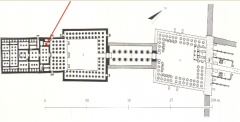
Why is the number 8 important? |
Amenhotep III hypostyle hall- 8 columns across
offering hall (arrow) still has the decorations (degraded over time or people took stones to build something else)
- the number 8 is important because of the mythology of temples in general
|
|
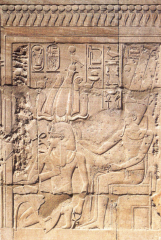
|
Coronation scene of Amenhotep III and Amen-Re – Luxor Temple – hall of appearances
Hall of appearances is where the deification of the living king and his ka took place, repeated each year. |
|

where?
What crown?
what is it depicting? |
Luxor
Union between the King (amenhotep III) and Amun (hodling hands) located in the central shrine area, the holy of holies.
- wearing the blue crown |
|
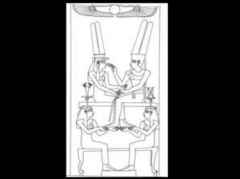
|
Divine birth scene from Luxor temple, Amenhotep III
- scenes of fertility aspect |
|
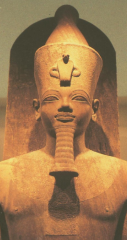
|
Life sized quartzite statue of Amenhotep III on a sledge – Luxor cachette
Cachette: - big pit that was dug in antiquity inside luxor temple
we think it’s a statue in stone of his cult statue (stone version of his cult image) |
|

|
Luxor Temple Plan - Amenhotep III rebuilt this holy of holies area
|
|

|
Life sized quartzite statue of Amenhotep III on a sledge – Luxor cachette
Cachette: - big pit that was dug in antiquity inside luxor temple |
|
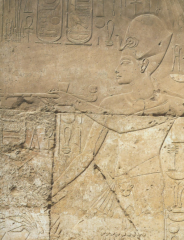
|
Tutankhamen making offerings in Opet Collonade – Luxor Temple
King Tut returned to the values and norms common before the Amarna period (Akhenaten). He is here burning incense and offering libations to Amun. Horemheb wrote his name over king Tut’s.
Luxor - continues to be a place where kings renew his royal spirit every year |
|
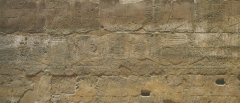
|
Processional movement of barques for Mut and Khonsu during the Opet Festival – Luxor Temple colonnade, western wall. Different types of priests accompany the boats: lector priests pray and supervise, they wear leopard skins
- images of the actual Opet festival |
|
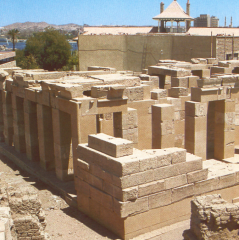
|
The Satet temple: 18th Dynasty temple at Elephantine Built by Hatshepsut as a completely new building (did not cover an older version). Was later dismantled and blocks re-used in succeeding temple=we can reconstruct it relatively well.
- Satet is new deity that we haven’t seen |
|
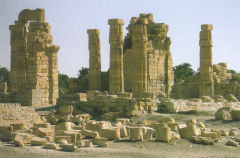
|
Temple of Amenhotep III at Soleb, Upper Nubia, the Shrine of the “Lord of Nubia” dedicated to both Amun-Re and Amenhotep III.
- it was a very large building |
|
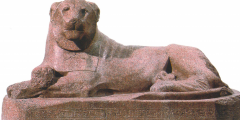
|
Soleb lion of Amenhotep III – Gebel Barkal – Upper Nubia – red granite=the deified manifestation of Amenhotep III
this is the statue of Amenhotep III as a lion (when he envisions himself as a God) |
|
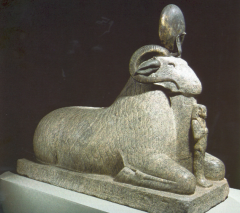
|
Soleb Amen-Re as a ram with Amen-hotep III – Gebel Barkal – Upper Nubia Ram was one manifestation of Amun flanked the processional route leading from river to the entrance pylon
mummified statue of Amenhotep |
|
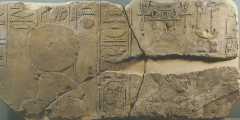
|
Early depiction of Amenhotep IV – from temple of Re- Horakhty in Karnak
- Ra- Horakhty (another manifestation of the Sun) Amenhotep III succeeded by his son, Amenhotep IV (could have been coregent) • Amenhotep IV continued father’s building projects, emphasis on sun god: Ra-Horakhty (falcon head w/ sun disk (Aten)) |
|
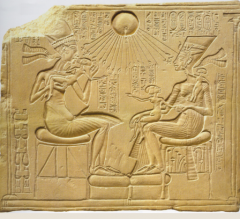
|
Limestone altar stela of Akhenaten and Nefertiti - household shrine at Amarna - Berlin
Amenhotep IV then instituted a religious revolution, focused on the sun disk Aten, and changed his name to Akhenaten. He eventually moved the capital of the country to an entirely new place, Akhetaten, modern Tel el-Amarna (Amarna for short). He also changed all of the stylistic norms that had continued for millennia.
Amarna is a great time for external relationships and art representation |
|
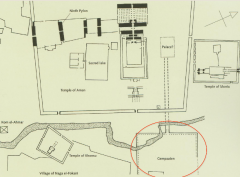
|
The Aten temple at Karnak
- built Aten temple into major sanctuaries at Karnak |
|
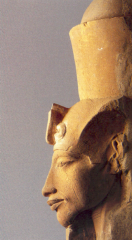
|
Colossal pillar statues of Akhenaten from Aten temple at Karnak, Thebes, sandstone, Cairo Museum
- facial features are exaggerated and elongated (long nose, chin) |
|

|
Colossal pillar statues of Akhenaten from Aten temple at Karnak, Thebes, sandstone, Cairo Museum
Traditional frontal pose, king wears traditional insignia: double crown, afnet- headdress, heqa- crook and the nekhakha-flail. But proportions are unique: long neck, narrow shoulders, full hips, saggy belly, crescent navel. Narrow long eyes, full lips, large chin. |
|
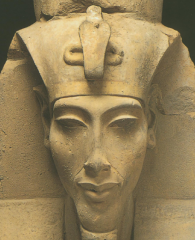
|
Akhenaten; NK; dyn 18; Aten temple?
- these lines on his face are distinguished for this King |
|
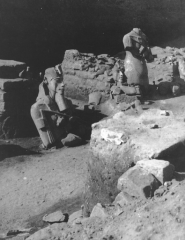
|
Colossal pillar statues in situ – Eastern Karnak
- Aten temple can only have images of the king because Aten doesn’t have a form |
|

|
rays of Aten with hands holding the Ankh symbol
All decoration in sunk relief |
|

|
Sed Festival Scenes – Karnak
- small format reliefs (we’re used to see larger format reliefs); very detailed depictions
All decoration in sunk relief |
|
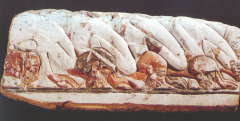
|
Kneeling emissaries – Aten Temple at Karnak
different cultures paying hommage to Akenaten
Libyan, Palestinian, Northern Syrian, Libyan |
|
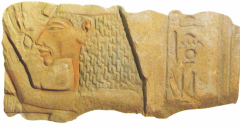
|
Nefertiti receiving life from the Aten – Aten temple at Karnak
- his wife, Nefertiti, was depicted like the King with long hair |
|
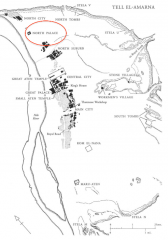
|
Akhetaten = The horizon of the Aten= Tell el Amarna: The brand new capital city; started in year 5 of his reign (same time he changed his name)
- moved the capital in Middle Egypt, called Akhetaten in the crook in the valley |
|

|
North palace – Tell el-Amarna
- not much is left |
|

|
Calcite block from balustrade of a ramp at the palace - Amarna
Exaggerated representation of the facial features and physiognomy should not be seen as realistic but has religious meaning: quality of fertility gods. Also, King’s thighs are shown up to the belly-button (but no genitals). Traditionally males were opaque kilts that reveal nothing
- his wife has a pelvic triangle |
|
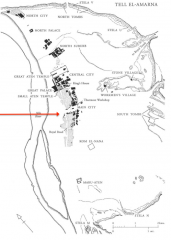
|
Royal Road
- runs through the city that connects the palace to temple area |
|

|
Instead of cult statues of the Aten (who didn’t have a human form), Akhenaten himself became the living manifestation of the deity. • So, the city was deliberately laid out to provide a setting for his display. • King and Queen drove south along the royal road every day from palace to administrative and ritual part of the city. • Here, they drive separate chariots, followed by 4 daughters, people bowing |
|

|
Great temple to the Aten, Amarna aka “Per-Aten” Here, the sun acted as the cult image. No enclosed sanctuaries dots= alters
individual alters for the royal family (opened roofed); private prayer rooms |
|
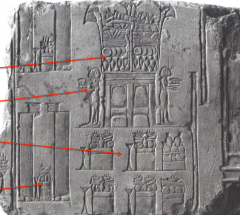
|
1) main alter 2) statues of akhenaten 3) smaller alters (each had an insenct burner on the side so you can pile offerings) 4) doorway to small side chapel (you can peek inside and see another alter inside with an inscene burner)
main altered piled with a lot of stuff, lilies, food, statues on Akenaten on either side |
|
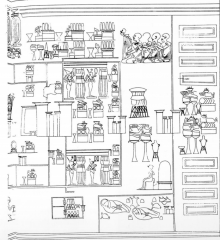
|
Drawing of scenes of architecture and statuary, tomb of high priest of Amen Merira
Pylon, colonnaded court with altars and statues of the king, interior with seated statue of the king and a benben stone |
|
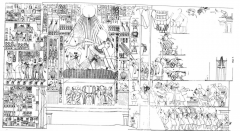
|
Tomb of Parennefer – window of appearances
- king and queen will wave at everybody and ppl will worship them (Akenaten) |
|
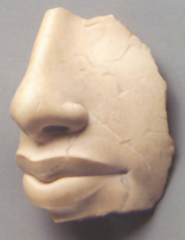
|
Fragment of a statue of Akhenaten from the Great temple to the Aten, Amarna, limestone
Large numbers of statues of the king and queen inside the temple This fragment can be identified as the king based on the shape of his lips and the line from noes to mouth |
|

|
Fragment of the queen, Nefertiti from the Aten temple
- she was very important in the royal ideology |
|
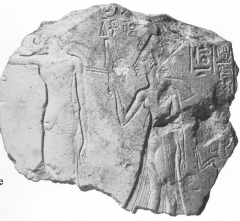
|
Limestone block of Akhenaten and Nefertiti, Amarna temple
Another good example of the difference between male and female bodies during the Amarna period
- king and queen doing ritual acts |
|
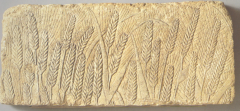
|
Limestone block of grain field – Amarna – probably Aten temple
- has to do with the sun giving life |
|

|
Small temple to the Aten (Pa-hut-Aten) at Amarna = royal mortuary temple
Surrounded by enclosure |
|

|
Limestone altar stela of Akhenaten and Nefertiti with their 3 oldest daughters (from household shrine)
The royal couple was venerated as the creator’s first two creations representing male and female principles.
- private tombs of the same period (Amarna period) have a lot of these ideologies depicted on their walls |
|

|
Altar statuettes- Amarna- private household shrines
These statues functioned as objects of veneration and as mediators between the household and the Aten
- little statues to worship the king and queen inside homes and tombs in elites and in common people’s |
|

|
Altar statuettes- Amarna- private household shrines
These statues functioned as objects of veneration and as mediators between the household and the Aten
- little statues to worship the king and queen inside homes and tombs in elites and in common people’s |
|
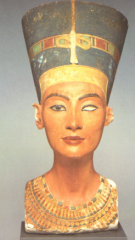
|
Bust of Nefertiti – limestone – sculptor’s workshop - Amarna
Dogmatic stylistic norms of the early period of Amarna replaced by moderate and idealizing tendencies. Toward end of the Akhenaten’s reign the stylistic trend was to be faithful to nature. Produced some of the most naturalistic portraits in Egyptian art Quite the turn-around…
- carved in stone, plastered, and painted |
|

|
Plaster head of Akhenaten – sculptor’s workshop – Amarna
Life-sized head consists of two joined halves. Facial features illustrate the more balanced late style of his royal portraits.
- toning of exaggerated features of the King |
|
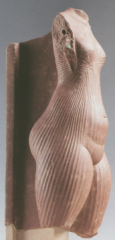
|
Red quartzite statue of Nefertiti (?)
See-through pleated garment. Torso gives “expression to femininity and the idea of fertility”
- female torso, one of the royal family members (not sure if it’s the queen) |
|
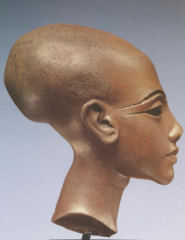
|
Head of one daughter of Akhenaten, found in the sculptor’s workshop. Reality or artistic trope?
- one of the daughters |
|
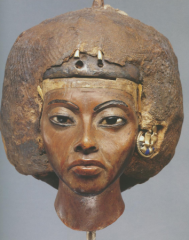
|
Wood head of Queen Tiy
Tiy was the Queen Mother of Akenaten. Played an important role in the royal cult of Akenaten at Amarna. She moved to Amarna with Akenaten in year 5 of his reign
- she was a powerful lady |
|

|
elite tomb
Less extreme Amarna style with slightly wider shoulder, lower small of the back than earlier style. Upper torso is in better proportion to the total body height. |
|
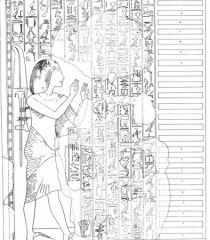
|
Tomb of royal scribe Ahmose worshipping the Hymn to the Aten
Officials and elites copied the royal style, though to a slightly lesser degree. Proportions are less extreme, but they show similar changes: narrow shoulders, high small of back and pronounced butt and belly folds.
- ppl under the royal family’s service also copy their styles |
|
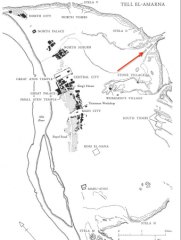
|
Royal tombs at Amarna
Akhenaten and his family were buried in a rock-cut tomb located in a wadi that ran back into the eastern cliffs of Akhetaten. Series of stairs and corridors led down to a burial chamber. Decoration survives in fragments and is completely different from the previous periods: no journey of the sun, no Osiris, no other funerary gods.
- family was buried in a similar fashion like the valley of the kings (cliff desserts, carved tomb) |
|
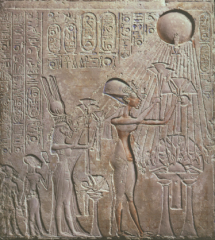
|
Limestone slab from royal tomb – Amarna – grid = 20 squares, 2 extra squares (1 for neck-head area and 1 for torso and large stomach)
Instead of typical scenes of the afterlife, decoration shows king, queen and royal daughters offering to the Aten. Main tomb used for Akhenaten, but robbed and sarcophagus smashed: but iconography showed on each side a large image of Aten each arm holding an ankh (instead of canopic gods) and on the corners figures of Nefertiti with arms outspread (instead of Isis, Neith, Nephthys and Selket)
- there were multiple tombs for the royal family with different chambers branching off |
|
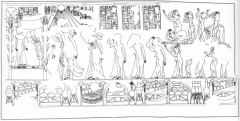
|
Royal tomb – scene of mourning Meketaten – Amarna
Two subsidiary tombs led off of the main royal tomb. One series of corridors and rooms was unfinished and undecorated (may have been intended for Nefertiti)
- servants are in a pose of mourning (hand on their heads)
|
|
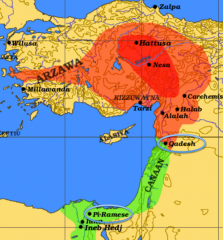
|
The Eastern Mediterranean: Green=Egyptian Empire Red=Hittite Empire
Egyptians controlled half on Levant |
|
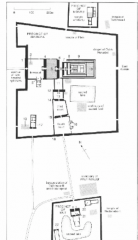
|
Plan of Karnak |
|
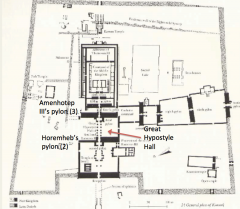
|
- major addison that the 19th dynasty Kings did was the Great Hypostyle Hall |
|
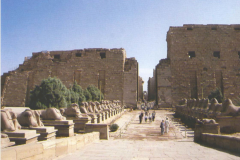
|
First Pylon, Karnak, 30th Dynasty and avenue of ram sphinxes bearing name of Ramses II originally led from the harbor to the hypostyle hall
- when you walk into Karnak (the first pylons) |
|
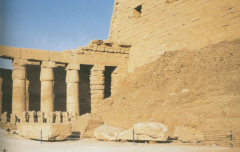
|
Mudbrick scaffolding from the First Pylon; Ramses II (Karnak)
- pylons were built from mudbrick hills |
|
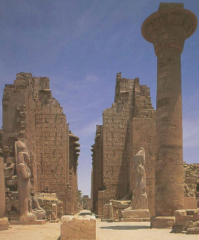
|
Statue here: sculpted during Thutmose III time but usurped by Ramesses II (at Karnak)
Standing in the first court, looking at the second pylon and the Hypostyle Hall behind it
- their statues (Ramesses II) leading into their great hypostyle hall (entrance decroation pylons |
|
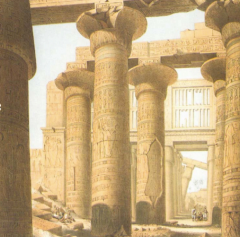
|
Great Hypostyle Hall; Ramesses II; Karnak Drawing from 1845 High nave (central area) with open papyrus umbel columns and latticed windows in the sides of the high walls. Behind (falling down) are the lower southern side aisles with papyrus bud columns.
- the hall itself is well preserved |
|

|
Ramesses II, Karnak
naves with peristory windows
walls would have extended upwards |
|
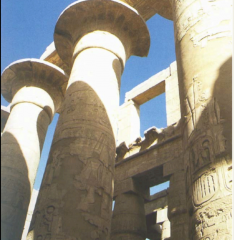
|
Ramesses II, Karnak
- under the umbel, we see stylized plant budding out |
|

|
Ramesses II. Karnak
peristory window |
|
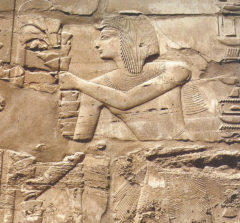
|
Pylon relief of Seti I, He is offering floral bouquets. Common sacrificial offerings to the gods at this time. In connection with Amun, bouquets had a special significance: the “bouquet of Amun at karnak” is offered also to the deceased as a regeneration wish.
- facial features look like the 18th dynasty Kings: curvy nose, smaller features, almond shaped eyes, body is not too defined but the relief stands out well - the walls were also decorated |
|
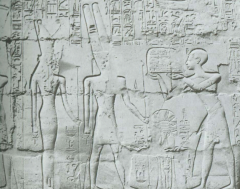
|
Scene on west wall of Hypostyle hall; Karnak Ramesses II offering a tray of food to Amun-Ra and Mut.
Sunk relief, even though it is inside! Akhenaten’s use of sunk relief stuck for the the reign of Ramesses II
- Ramesses II took over Sety I’s building projects |
|
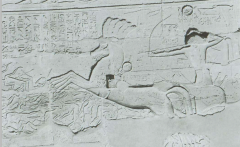
|
Northern exterior wall of Hypostyle hall. Battle scene with Sety I against the Shasu in Canaan during his first year as king. Heroic pose: no charioteer. Sun disk and Nekhbet above him, ankh symbol holding a fan behind. Text: king “prevailed over them like a lion, making them into heaps of corpses throughout their valleys”
- jumble of ppl in front of him |
|
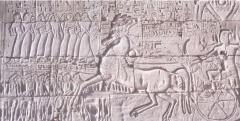
|
Northern exterior wall of Hypostyle Hall. Seti I battle against the Hittites and Syro-Palestinian tribes (including Shasu). Here he is mounting his chariot with captives in front of him.
his captives, arms are bound |
|
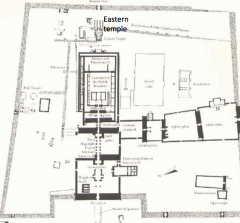
|
Ramesses II also built the “Eastern Temple” at the back of the Amun temple. Not much of it remains
eastern temple- separated building located behind the temple of Amun they also decorated the outside of these walls that led back to the eastern temple; using procession ppl would walk through these walls |
|
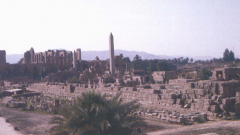
|
Ramesses II decorated parts of the outer walls of the external enclosure wall surrounding the precinct of Amun-Ra. Decoration was of scenes of the rituals performed inside the temple. |
|
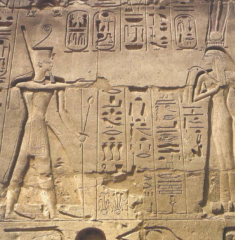
|
Southern enclosure wall, Karnak. Ramesses II before Ahmose-Nefertari
“Ahmose-Nefertari, god’s wife, god’s mother, great wife of the king, ruler of the Two Lands” she was the wife of Ahmose, founder of the 18th dynasty and the mother of Amenophis I. she was worshipped as a deity.
(wife of Ahmose, first King of 18 dyn) |
|
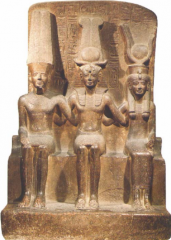
|
Triad of Ramesses II between Amun-Ra and Mut. Ramesses II assumes the role of the son of the god and is crowned with divine ram’s horns, the sun disk, and ostrich feathers. They all embrace
king shown as son of Amun and Mut |
|
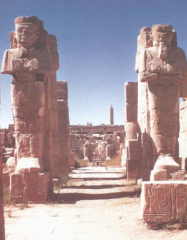
|
Ramesses II’s Eastern Temple at Karnak (behind temple to Amun) Temple dedicated to Re-Harakhty and Amun who “hears the prayers” Two large figures of Osiris flank the entrance in front of the central axis of the temple. |
|
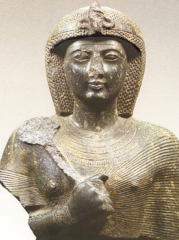
|
Fragmentary seated statue of Ramesses II, Middle Egypt, Thinis. Also First Style
wearing pleated garment with a different wig on |
|

|
Ramesses II: First Style. Originally from the Eastern Temple Wears the Blue Crown, a finely pleated robe and holds the royal crook. To the left and right beside his legs are figures of his son Amunherkhopeshef and his wife Nefertari. Iconography and facial features are clearly those of the young Ramses
- he reigned for so long that his image changed over time (we divide it into first and second style) |
|
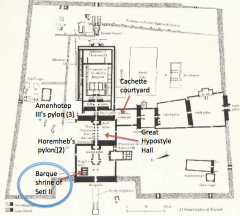
|
Sety II build a little barque shrine, well preserved |
|
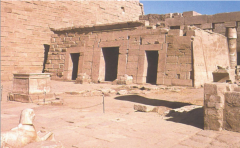
|
Processional Barque (boat) shrine of Seti II, 19th Dynasty. Used for the Theban Triad during Festivals.
true tri-part shrine |
|

|
Standard bearing statue of Seti II from his processional barque shrine. Now at the Louvre.
his titles are on these |
|
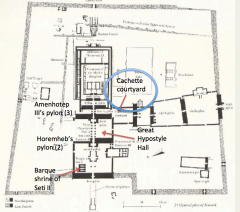
|
Cachette Court, Karnak; Ramese II
- the name modern people gave to this particular courtyard (connects N/S to E/W)
|
|
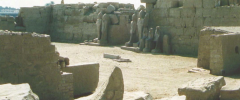
|
Cachette Court, Karnak; Ramese II
Discovered in early 20th century.
- it has an area buried with statues |
|

|
Statue of Rameses-nakht from the Cachette. Late Ramesside period, 20th Dynasty. High Priest of Amun Rameses-nakht belonged to the elite class of Theban society and held his office during the reigns of Ramesses IV to Ramesses IX. Kneeling pose with statue group of divine triad on a pedestal
- statue of a priest |
|
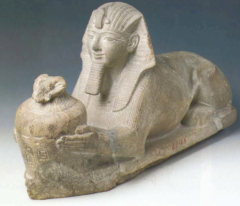
|
Sphinx of Ramesses II with a “vase for Amun” Presents the king as divine cult ruler. This one shows human hands unlike most other sphinxes
he has human hands (other sphinxes is all animal except for the head) |
|
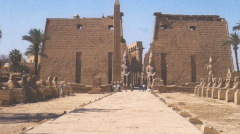
|
Entrance pylon with avenue of sphinxes. Two rows of 365 human headed sphinxes led from the precinct of Amun at Karnak to the Luxor temple. These date to the 30th dynasty, though there would have been earlier ones too.
entrance pylon Ramesses II built to Luxor |
|
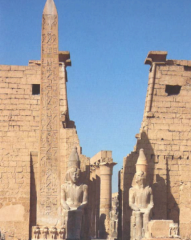
|
Façade of the entrance pylon. Originally six colossal statues and two obelisks erected by Ramesses II Two seated figures and one standing one survive in their original locations. The other obelisk is in the Place de la Concorde in Paris.
they put the gold back on to the pyramidion so that the sun is illuminating it (all the pyramids and obelisks will have this glowing, magical looking point to it) |
|

|
Battle scene with Ramesses II shooting an arrow from his chariot. Similar to Sety I at Karnak. |
|
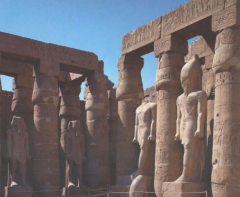
|
Court of Ramesses II Surrounded on three sides by a large colonnade with papyrus bud columns. Between the columns were colossal standing statues Ramesses II erected some on his own, but also reused older statues of Amenhotep III, whose names had been erased during the Amarna period.
some of the statues are already there and he put his own name on them and he also added some of his own |
|
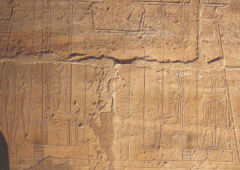
|
Representation of the entrance pylon, relief on the southern wall of court: two obelisks, tall flagstaffs, statues of Ramesses II. Profile perspective assumed for 2D image.
wall image of the entrance pylon |
|
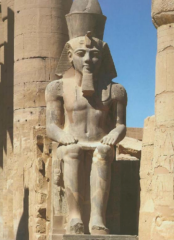
|
Granodiorite colossal statue of Ramses II from first court at Luxor Temple, entrance to the colonnade. Second Style. Bears the proper name of Ra-en-hekau “sun of the ruler of foreign lands” may refer to the beneficial aspects for foreign lands of Ramesses II’s rule. His wife Nefertari is in front of the throne beside right leg. Overwhelming image of kingship: double crown, rearing uraeus, nemes headdress, royal beard and sides of throne are sema tawy motif.
ka statue that you can pray and give offerings in place of the King |
|
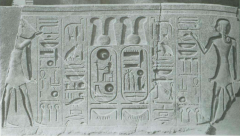
|
Base of Ramesses II’s colossal statue: detail of the front of the pedestal. Two figures of the Iunmutef priest, wearing characteristic leopard skin and plaited side-lock (hair), make the ritual gesture of offering to the paired cartouches of Ramses II. The text reads “Take to yourself the offerings and provisions that go forth from the presence of your father Amun-Ra for the living royal ka, Ra of the Rulers”
base of Ka statue
|
|
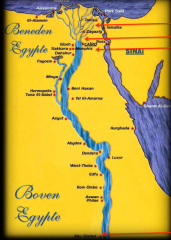
|
Pi- Ramesse (new city made in the Ramisside period (northern capital))
Heliopolis remains (city dedicated to the Sun)
Temple to Ptah
Temples to RII and Nefertari at Abu Simbel (in Nubia that Ramesses II built of himself) |
|

|
Hypothetical plan of Memphis, Temple to Ptah (the city’s patron deity and one of the “creator gods”) Not much of this place is left for us…very fragmentary pieces of buildings, etc.
- we had 2 large precincts and Rameses II built up one of the main temples of Ptah |
|
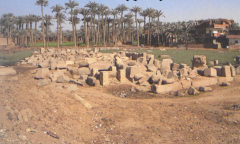
|
Temple of Ptah at Memphis-- Ramses II's hypostyle hall
used to by a hypostyle hall |
|
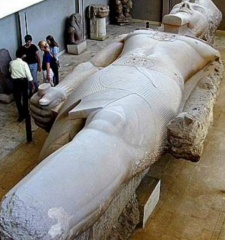
|
- his colossal statue is still here |
|
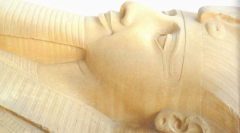
|
Crystalline limestone. Once standing before the southern portal of the temple of Ptah. One of the highest quality statues of Ramesses II. Technical execution and surface polish are amazing.
- quality of statue is also very great (era after the peace treaty); resources the King is able to put aside for his projects |
|
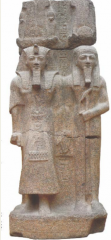
|
Diad statue of Ramesses II (left) and
King and God have the same faces |
|
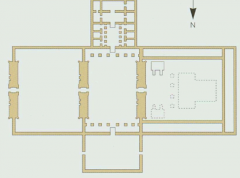
|
Temple to the sun god at Heliopolis: reconstructed plan. Not much is left, like Memphis.
- place that was dedicated to the Sun God |
|

|
Ramesside processional route and way station at Heliopolis
during the ramesside period, there is a processional route and barque (way) station |
|
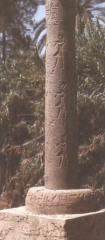
|
Red granite victory column of Merenptah, Heliopolis. Commemorating victory over “Sea Peoples” precursor of classical victory columns (wasn’t used to hold anything up; not architectural). Placed beside the processional avenue to the obelisk temples of the MK.
- red granite victory column commemorates specific moments in history— victory over the Sea People |
|
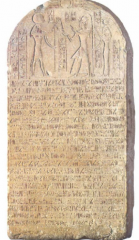
|
Monumental stela of Ramesses II, near Heliopolis from the eighth year of his reign. Upper part shows Ramesses II with Hathor before the falcon-headed Re-Harakhty. God hands him the insignia of kingship. Long inscription below reports that the young king stayed at Helipolis and considered how he might give pleasure to his father, the sun god Re-Harakhty by means of monuments for his temple “He traveled through the desert…near Heliopolis (and came) to the Red Mountain (quarry area). There His Majesty found a mighty block of quartzite the equal of which has not been found since the time of Re and it was taller than an obelisk of granite.” the king gave this block to his sculptors who within a year fashioned it into the colossal statue “Ramesses, Miaamna, the god”.
- he erected other statues at Heliopolis and other architectural building based on this commemorating stealae which basically describes in detail his dedication to make the largest statue of the Sun God |
|
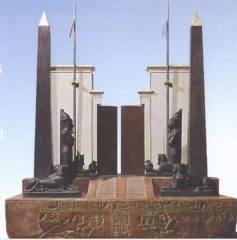
|
Ancient quartzite model of the Heliopolis temple Slots in the top surface of the model’s base show that there was a pylon gateway in front of which were two obelisks, two standing royal statues in ceremonial costume and two pairs of sphinxes. In the images running around the sides of the base Seti I can be seen in the “kneeling run” making offerings to the gods Re-Harakhty and Atum.
- like a model of a temple that would have been erected in the Ramesses period - only this section is real |
|

|
Ramesside Ruins at Tanis-- Originally from temples at capital Pi-Ramesse
Rulers of the new Libyan dynasties from 1045 BC abandoned the city of Pi-Ramesse and moved everything to their new city, Tanis. When excavations began, everyone though Tanis was Pi-Ramesse.
- new capital was created: Pi- Ramesse |
|
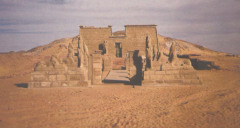
|
Wadi es Sebua, Temple of Ramses II; avenue of sphinxes
this used to be much closer to the river
|
|
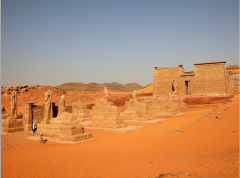
|
- spinx entrance |
|
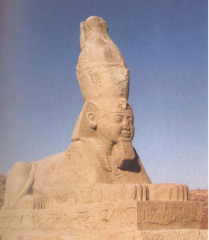
|
Sphinx of Ramesses II, Wadi es Sebua, sandstone; the sphinxes in the first courtyard have human heads, those in the second have falcon heads and a smaller statue of the king in front of the breast
- double crown, nemes headdress, crown is overemphasized (we’re in Nubia so kings want to emphasize their power in places where he’s not as actively taking part in the culture) |
|
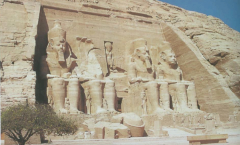
|
Abu Simbel; Nubia; Temple of Ramses II
- this is the larger temple (there are 2) |
|
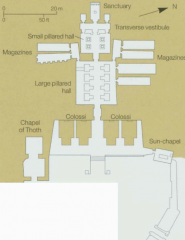
|
Abu Simbel; Nubia; Temple of Ramses II Temple carved 60 m into the rock with two columned halls and storerooms.
the longer rooms are storage, located on the side |
|

|
Abu Simbel; Nubia; Temple of Ramses II - each one of his statues had a different name (different manifestations of the King as a deity) |
|

|
Abu Simbel; Nubia; Temple of Ramses II Pillared hall: Two rows of four roof supports. In front of which are colossal standing figures of the king: ceremonial kilt, royal beard, crowns of the two lands and crook and flail. These statues also have titles indicating they represent the deified ruler.
- mummy form collosal statues of the King |
|
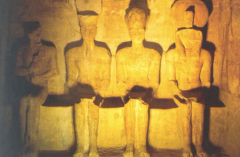
|
Abu Simbel; Nubia; Temple of Ramses II Temple Sanctuary: Ramesses II with the three great gods of the empire: Ptah, Amun-Re and Re-Harakhty. Here the king is of equal status. On the days of the equinoxes (Feb. 20 and Oct. 20) the rays of the rising sun illuminate the group.
- king in company with the deities |
|
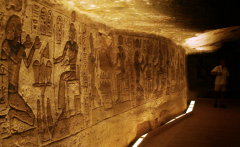
|
Abu Simbel; Nubia; Temple of Ramses II rock cut aspect of this temple of Ram |
|
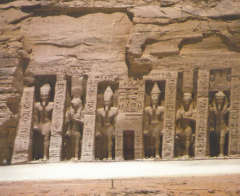
|
Small Temple dedicated to Queen Nefertari, to the north of the Large temple to Ramesses II. Her role as the goddess Hathor, the King’s beloved and mother of the royal children. Statues of the king alternate with statues of the queen. Smaller statues of the princesses stand next to queen; princes next to king.
- he gave his head wife a temple |
|
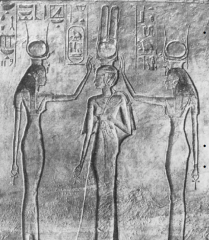
|
Relief scene inside temple (dedicated to Nefertari) Queen Nefertari, the first principal wife of King ramses II being crowned by goddesses Hathor and Isis. Nefertari wears the typical queens crown of the period, which combines the two tall falcon feathers with the sun disk and horns of Hathor. She stands facing left between the goddesses who raise their arms to each side of the crown.
- on the side of temple, it’s more clear that it’s a temple for the Queen as a goddess |
|
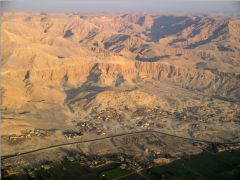
|
mortuary temples were closer to the land of the living - valley of the Kings in the far top left - Sety's tomb is more to the North |
|
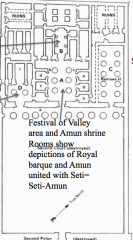
|
Built to the north of the other temples. Chapel for Ramses I, Seti’s father Barque sanctuary of Amun-Re with rooms for Mut and Khonsu *addition of storerooms was new-now it was self-sufficient
the mortuary temple of the kings on the western side of the nile are used in procession for the beautiful feast of the west |
|
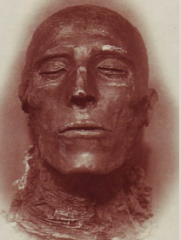
|
Sety I Sety I’s mummy |
|
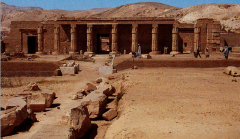
|
Mortuary Temple of Seti I –Qurna - Thebes
3 entrances |
|

|
Depiction of Amun’s barque on the wall of his barque sanctuary |
|
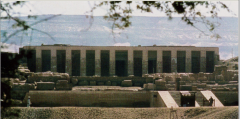
|
Osiris Temple of Seti I – Abydos
- Abydos is the place of Osiris |
|
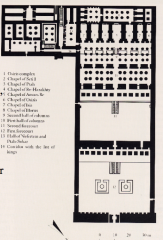
|
Osiris Temple of Seti I – Abydos
Individual chapels for the Triad of Abydos: Osiris, Isis, Horus |
|
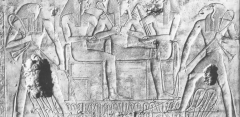
|
Scene from Seti I’s chapel: king with Nekhbet, Wadjit; Horus and Thoth have triple sema-tawy
reliefs in each chapel relates to the deity it belongs to |
|

|
Seti I seated on the lap of his divine mother, Isis. He wears ceremonial kilt and golden royal cap Isis holds him in a motherly gesture.
he’s depicted smaller to look like the son of Isis |
|
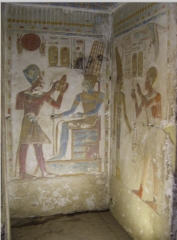
|
Cult image of Amun and the king, from Amun’s chapel within Temple of Seti I King performs the daily ritual in front of the statue. Prescribed series of actions performed by the king or priests: entering sanctuary; opening shrine with cult image; fall down before the god; offering gifts; cleaning cult image; dressing it up; then leaving |
|
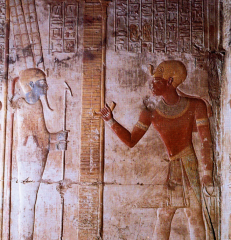
|
Cult image of Amun and the king, from Amun’s chapel within Temple of Seti I King performs the daily ritual in front of the statue. Prescribed series of actions performed by the king or priests: entering sanctuary; opening shrine with cult image; fall down before the god; offering gifts; cleaning cult image; dressing it up; then leaving
the other chapels have the king performing daily rituals associated with cult images (statues) of the gods |
|
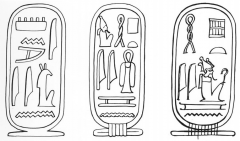
|
it’s (Sety) a form of the name Seth |
|
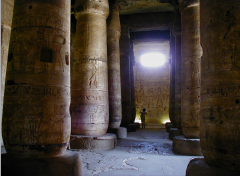
|
- first hypostyle hall in the temple |
|
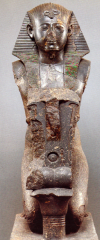
|
Kneeling figure of Seti I – Abydos temple of Seti I
He presents the gods of Abydos with a tray of offerings. The foot of the plate is formed by the hieroglyph ka “sacrifice” on a lotus bud.
- kneeling in front of a hieroglyph saying “sacrifice” |
|
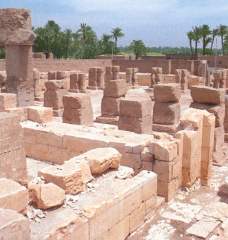
|
Abydos temple of Ramses II
Similar idea as Seti I’s temple. Chapels to many gods, including his father. Functioned as a way station during festivals, including procession of the reliquary for the head of Osiris is carried to his tomb (depicted on the walls) |
|
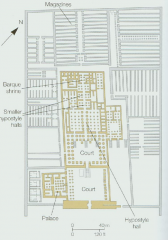
|
“Ramesseum” of Ramesses II, Mortuary temple Two courts leading to hypostyle hall, then three enclosed rooms, then the sanctuary, now completely gone Palace located on the southern side of the first court: the typical location in the 19th and 20th dynasties. Vaulted storage facilities surround the mortuary temple
- the grey areas, long skinny areas are storage areas for food and goods |
|

|
Ramesse II's mummy suffered from a lot of dental problems and arthritis |
|
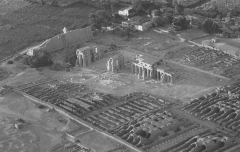
|
Ramesseum |
|
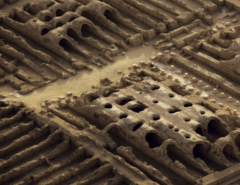
|
storage magazines in Ramesum |
|

|
Kadesh Battle Relief Ramesseum pylon interior
battle scene of Kadesh against Hitis in the Levant which resulted in a peace treaty |
|
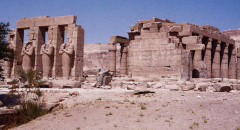
|
Ramesseum: second court and Hypostyle hall.
entrance to the second court is mummified osiride statues of the King |
|
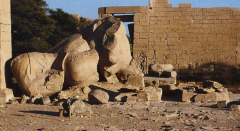
|
Colossal statue of Ramesses II, originally 19m high. Weighs 1000 tons made of red granite: largest seated statue of Western Thebes
the idea that bigger is better |
|
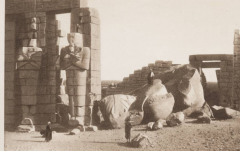
|
Colossal statue of Ramesses II, originally 19m high. Weighs 1000 tons made of red granite: largest seated statue of Western Thebes
the idea that bigger is better |
|

|
reconstuction |
|
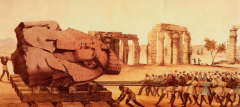
|
Transportation of the bust of “Young Memnon” by Giovanni Belzoni in 1816. Shipped up the Nile to Alexandria, then to London where it is still…..
- it’s not really Memnon |
|
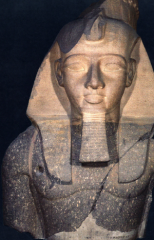
|
“Younger Memnon” – seated statue before pylon, Ramesseum – British Museum –red granite and granodiorite
stone as dual colouring to it |
|

|
Ramesseum – hypostyle hall
- tripart type section (like the churches) |
|
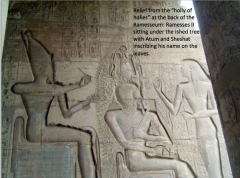
|
Relief from the “holly of holies” at the back of the Ramesseum: Ramesses II sitting under the Ished tree with Atum and Sheshat inscribing his name on the leaves.
- ished tree has naming of all the kings and deities on the leaves cult center (relief on teh holly of holies area) |
|
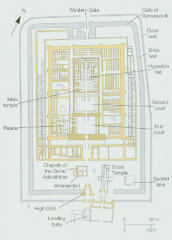
|
Mortuary Temple of Ramesses III at Medinet Habu Very similar plan to the “Ramesseum” of Ramesses II: two open courts, palace to south of first court, hypostyle hall, “holy of holies” Surrounded by a huge fortress wall with two tower entrances.
- almost an exact relipa of the Ramuseum 18th Dynasty temple to Amun as the Primeval god enclosed by the great wall, here labeled “small temple” |
|
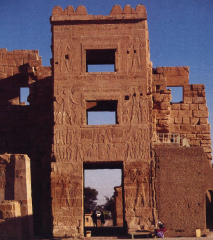
|
Medinet Habu – funerary temple of Ramses III, Dynasty 20
The “High Gate”: eastern entrance. Constructed during his last years along with enclosure wall, admin buildings, stables, barracks, etc. This section was a core building of a multi-storied royal palace (he stayed here when visiting Thebes)
- high gate —> he could have lived here in his last years |
|
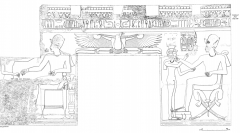
|
Scene from the interior of the High Gate showing the king playing the Senet game on the left with his daughter.
- king playing a Senet game with his daughter (she’s only partially preserved)
he is still very formal in his pose while his daughter is allowed to be more dynamic and move around |
|
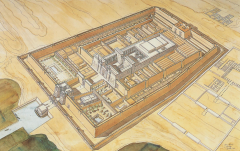
|
small temple has it’s own individual entrance |
|

|
First Pylon – Medinet Habu: best preserved pylon in Thebes. Façade has traditional smiting scene performed in front of Amun-Re and Re-Horakhty. Above entrance was a sanctuary to the sun.
lines= for flags to be inserted
2 smiting scenes in front of Amune Re and Re- Horakhty |
|
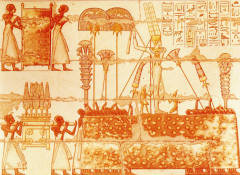
|
The Min festival, Medinet Habu, from second temple courtyard. Unlike most other gods in festivals, Min’s statue is in full view
- Min is full view (other gods’ statues are in a cabin as they are placed in boats) |
|
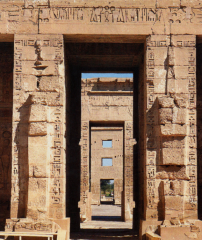
|
Medinet Habu View from second court into first court –
First court: scenes dedicated to warding off chaos: battles against Sea Peoples, Libyans, etc. Within the first court was the “window of appearances” and doorway to palace Second court: scenes of festivals |
|
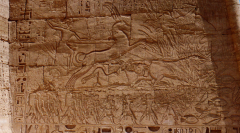
|
Hunting scene – back side of pylon, south side: unusual to have in a mortuary temple, but fits the theme of warding off chaos
- interior side of the pylon, first court yard |
|
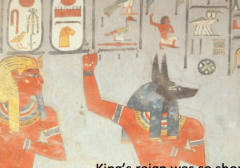
|
Ramesses I between the “souls of Pe and Nekhen”=Upper and Lower Egypt
King’s reign was so short that the only had time for a single burial chamber. Style is very similar to Horemheb: last king of 18th Dynasty
style of the Kings, outfit, poses are almost identical |
|

|
Typical Ramesside tomb plan – Valley of the Kings
In 19th D tombs now have a straight axis (instead of curved like 18th D).
in 18th dyn, only the entrance passage and the tomb was painted |
|

|
Seti I before a table of offerings
Belzoni discovered this tomb, he made this copy of the wall paintings, which had original color.
offering table, table with stylized bread, names and offering lists, nekbet protecting him with shen ring (symbol of eternity) |
|
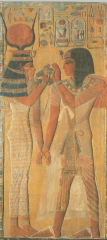
|
Seti I before Hathor – limestone pillar from his tomb
Hathor holds out her necklace for the king to touch: it was a symbol of rebirth. Interesting features: Hathor’s skin color is same as the king (unlike most other depictions where it is white). Her dress also had pattern with his name High quality of relief: transparent clothing of king
- best quality in reliefs and paintings |
|
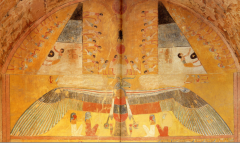
|
Burial chamber of Queen Tausret, Valley of the Kings. Depiction of the last scene in the “Book of Caverns”: another version of the Sun’s journey through the underworld Top to bottom, Re as: sun disk, child, beetle, winged goat-bird
- diversification of type of scenes that we see in these tombs |
|
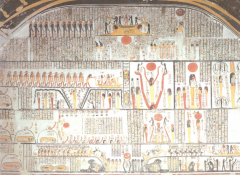
|
Book of Earth – burial chamber of Ramesses IV. Emphasizes the role of the earth gods Tatenen and Geb in the night journey of the sun. Here Nun (large arms) personification of the ancient waters, lift up the sun’s disk
sun gets through the underworld with the help of the Earth god |
|
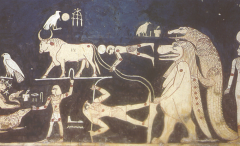
|
Astronomical ceiling – burial chamber of Seti I: above the mummy is this image on a vaulted ceiling: lists of stars, decan stars and constellations: Orion, Sirius, and the Big Dipper (Taurus).
- constellation on ceilings |
|
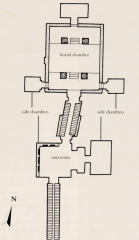
|
Floor plan of Queen Nefertari’s tomb Very similar to a king’s in design with antechamber and large burial chamber that includes side rooms and pillars. Decoration shows the Queen descending into the underworld with various deities, eventually merging with Osiris in the burial chamber
has long entrance way (the striation means there are stairs), anteroom, more stairs down, into burial chamber which also has storage
she’s not allowed to have images of the books on the wall because she’s not a KING |
|
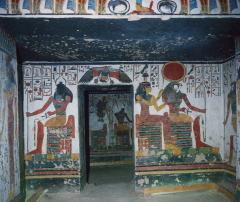
|
Tomb of Nefertari – wife of Ramses II – view from a side chamber Here: gods Khepri (scarab) and Re-Harakhty with Hathor
depicted herself with all the deities (her own version of how to get the underworld) |
|

|
Image for Spell 94 from the Book of the Dead: Nefertari receives a writing palette and a water bowl from the ibis-headed god Thoth. Technically since she wasn’t a king, she wasn’t allowed to use direct images from the royal books of the dead. |
|
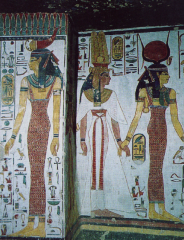
|
Nefertari is led on both sides of the corridor by deities into the passageway: here Selket on the left and Isis on the right.
goddess leading her to the underworld |
|
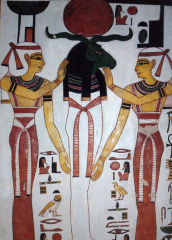
|
The mummy of the sun god:
- located in the back |

